Technical and Economic Analysis of Sustainable Photovoltaic Systems for Street Lighting
Abstract
1. Introduction
2. Materials and Methods
2.1. Public Lighting
2.1.1. Technical Standards
2.1.2. The Components of the Public Lighting System
2.1.3. Analysis of the Existing Situation
2.1.4. Selection of Lighting Classes
- Design speed for roads of technical class II: 50 km/h [49];
- Importance category: C [49];
- Road platform width: 7.00 m [49];
- Average distance between poles: 40.00 m;
- Maximum height for lighting fixture installation: 10.00 m;
- Number of lanes: 2;
- Distance from the curb: 3.00 ÷ 6.00 m;
- Pole placement: unilateral;
- Average reflection coefficient: 0.07—(corresponding to asphalt road R3).
- Design speed for roads of technical class IV: 40 km/h [49];
- Importance category: C [49];
- Road platform width: 5.50 m [49];
- Average distance between poles: 50.00 m;
- Maximum height for lighting fixture installation: 10.00 m;
- Number of lanes: 2;
- Distance from the curb: 1.00 ÷ 3.00 m;
- Pole placement: unilateral;
- Average reflection coefficient: 0.07—(corresponding to asphalt road R3).
- Design speed for roads of technical class IV: 30 km/h [49];
- Importance category: C [49];
- Road platform: 5.50 m wide [49];
- Average distance between poles: 50.00 m;
- Maximum height of the lighting fixture installation: 10.00 m;
- Number of traffic lanes: 2;
- Distance from the curb: 1.00 to 2.00 m;
- Placement of poles: unilateral;
- Average reflection coefficient: 0.07—(corresponding to asphalt road R3).
3. Results and Discussion
3.1. Calculation Summary
3.2. Analysis of Local Photovoltaic System for Street Lighting
3.3. Analysis of Central ON-GRID Photovoltaic System for Street Lighting
- Photovoltaic modules: composed of 144 monocrystalline photovoltaic cells and have a nominal unit power of 450 Wp. In the installation, 342 photovoltaic modules will be mounted to cover the electricity consumption of the analyzed public lighting;
- Power inverter: three-phase unidirectional with a nominal unit power of 60.00 kW (alternating current). Three-phase unidirectional power inverters will be installed in the system—three pieces;
- Mounting structure for photovoltaic modules: metal parts made of OL, sized and designed for the specific conditions of the project;
- Electrical panel: within the photovoltaic solar system, it provides switching devices and protective and/or measuring devices specific to photovoltaic systems. An electrical panel for the power plant will be installed in the system (TPV);
- Junction box for the PV arrays: a housing in which all the PV strings are electrically connected and where protection devices are located. In the installation, 22 junction boxes for the PV arrays will be mounted;
- The electrical cable networks within the photovoltaic solar include the energy cables laid in metal conduits up to the connection of the photovoltaic electrical installation to the distribution network of the national energy system;
- Grounding system: conductors and components used to establish equipotential bonds between the metallic elements associated with the photovoltaic solar installation and the conductors and components connecting to the grounding electrode of the metallic elements related to the photovoltaic solar system;
- Low-voltage electrical installation: data cables and equipment associated with the remote monitoring of the installed power inverters and the control and monitoring system of the installed power inverter.
3.4. Analysis of Using Central HYBRID Photovoltaic Systems for Street Lighting
- Replacing the three ON-GRID inverters with three HYBRID inverters with the same technical specifications;
- Implementing an energy storage system composed of 50 B-BOX systems, each including one cabinet and two lithium iron phosphate (LiFePO4) batteries with a battery management system (BMS) for use with an external inverter or charger;
- Extending the electrical network to connect public lamps to the solar energy source.
3.5. Analysis of Local Photovoltaic System for Street Lighting
3.5.1. Economic Viability Analysis
3.5.2. Calculation of Economic Efficiency
3.5.3. Quantitative and Percentage Reduction in Resulting Greenhouse Gas Emissions
3.6. Analysis of Using Grid-Connected Central Photovoltaic System for Street Lighting
3.6.1. Economic Viability Analysis
3.6.2. Calculation of Economic Efficiency
3.6.3. Quantitative and Percentage Reduction in Resulting Greenhouse Gas Emissions
3.7. Analysis of HYBRID Central Photovoltaic System for Street Lighting
3.7.1. Economic Viability Analysis
3.7.2. Calculation of Economic Efficiency
3.7.3. Quantitative and Percentage Reduction in Greenhouse Gas Emissions
3.8. Discussion
- -
- A ±20% variation in electricity price;
- -
- A ±10% variation in annual maintenance costs.
4. Conclusions
Author Contributions
Funding
Institutional Review Board Statement
Informed Consent Statement
Data Availability Statement
Conflicts of Interest
Nomenclature
| Acronyms | |
| PNIESC | The Project of the National Integrated Plan in the Field of Energy and Climate Change |
| EU | European Union |
| LEA | Overhead Power Line |
| VWS | Visual Weighted Score |
| PV | Photovoltaic |
| PVGIS | Photovoltaic Geographical Information System |
| BMS | Building Management System |
| UNI | Updated Net Income |
| PBT | Payback Time |
| DPBT | Discounted Payback Time |
| GHG | Greenhouse Gas |
| IRR | Internal Rate of Return |
| UPS | Uninterruptible Power Supply |
| NVR | Network Video Recorder |
| Parameters | |
| Lm | Average luminance [cd/m2] |
| Uo | General luminance uniformity coefficient |
| Ul | Longitudinal luminance uniformity coefficient |
| TI | Threshold increment |
| REI | Lighting efficiency ratio |
| S | Distance between poles [m] |
| H | Mounting height [m] |
| R | Clearance [m] |
| A | Overhang (advancement) [m] |
Appendix A
| Component | Parameter | Value | Quantity |
|---|---|---|---|
| Monocrystalline photovoltaic panel [55] | Nominal electrical power | 300 W | 2 pieces |
| Nominal current | 9.17 A | ||
| Short-circuit current | 9.78 A | ||
| Nominal voltage | 32.70 V | ||
| Open circuit voltage | 39.80 V | ||
| Dimensions | 1.640 × 990 × 30 mm | ||
| Solar regulator [56] | Maximum voltage | 100 V | 1 piece |
| Maximum charging current | 15.00 A | ||
| Low-voltage disconnect | 22.00 V | ||
| Reconnect | 25.20 V | ||
| Boost charging voltage | 28.80 V | ||
| Overvoltage protection | Yes | ||
| Reverse polarity protection | Yes | ||
| Degree of protection | IP32 | ||
| Size | 133.50 × 70 × 35 mm | ||
| Weight | 165 g | ||
| Gel solar battery [57] | Nominal voltage | 12 V | 2 pieces |
| Capacity | 120 Ah | ||
| Dimensions (L × l × h) | 410 × 175 × 227 mm | ||
| Weight | 33.50 kg | ||
| LED street lighting fixture [58] | Power | 60 W | 1 piece |
| Nominal voltage | 24 V | ||
| Degree of protection | IP65 | ||
| LED type | multiled | ||
| Auxiliary materials [47,59,60,61,62,63] | Battery box IP65, connectivity, protections, conductors, metal support, brackets, and OL-Zn collars | - | - |
| Component | Parameter | Value | Quantity |
|---|---|---|---|
| Monocrystalline photovoltaic panel [55] | Nominal electrical power | 250 W | 2 pieces |
| Nominal current | 9.33 A | ||
| Short-circuit current | 9.87 A | ||
| Nominal voltage | 26.80 V | ||
| Open circuit voltage | 32.84 V | ||
| Dimensions | 1.350 × 880 × 35 mm | ||
| Solar regulator [56] | Maximum voltage | 75 V | 1 piece |
| Maximum charging current | 10.00 A | ||
| Low-voltage disconnect | 22.00 V | ||
| Reconnect | 25.20 V | ||
| Boost charging voltage | 28.80 V | ||
| Overvoltage protection | Yes | ||
| Reverse polarity protection | Yes | ||
| Degree of protection | IP32 | ||
| Size | 133.50 × 70 × 35 mm | ||
| Weight | 165 g | ||
| Gel solar battery [57] | Nominal voltage | 12 V | 2 pieces |
| Capacity | 100 Ah | ||
| Dimensions (L × l × h) | 330 × 171 × 224 mm | ||
| Weight | 27.50 kg | ||
| LED street lighting fixture [58] | Power | 50 W | 1 piece |
| Nominal voltage | 24 V | ||
| Degree of protection | IP65 | ||
| LED type | multiled | ||
| Auxiliary materials [47,59,60,61,62,63] | Battery box IP65, connectivity, protections, conductors, metal support, brackets, and OL-Zn collars | - | - |
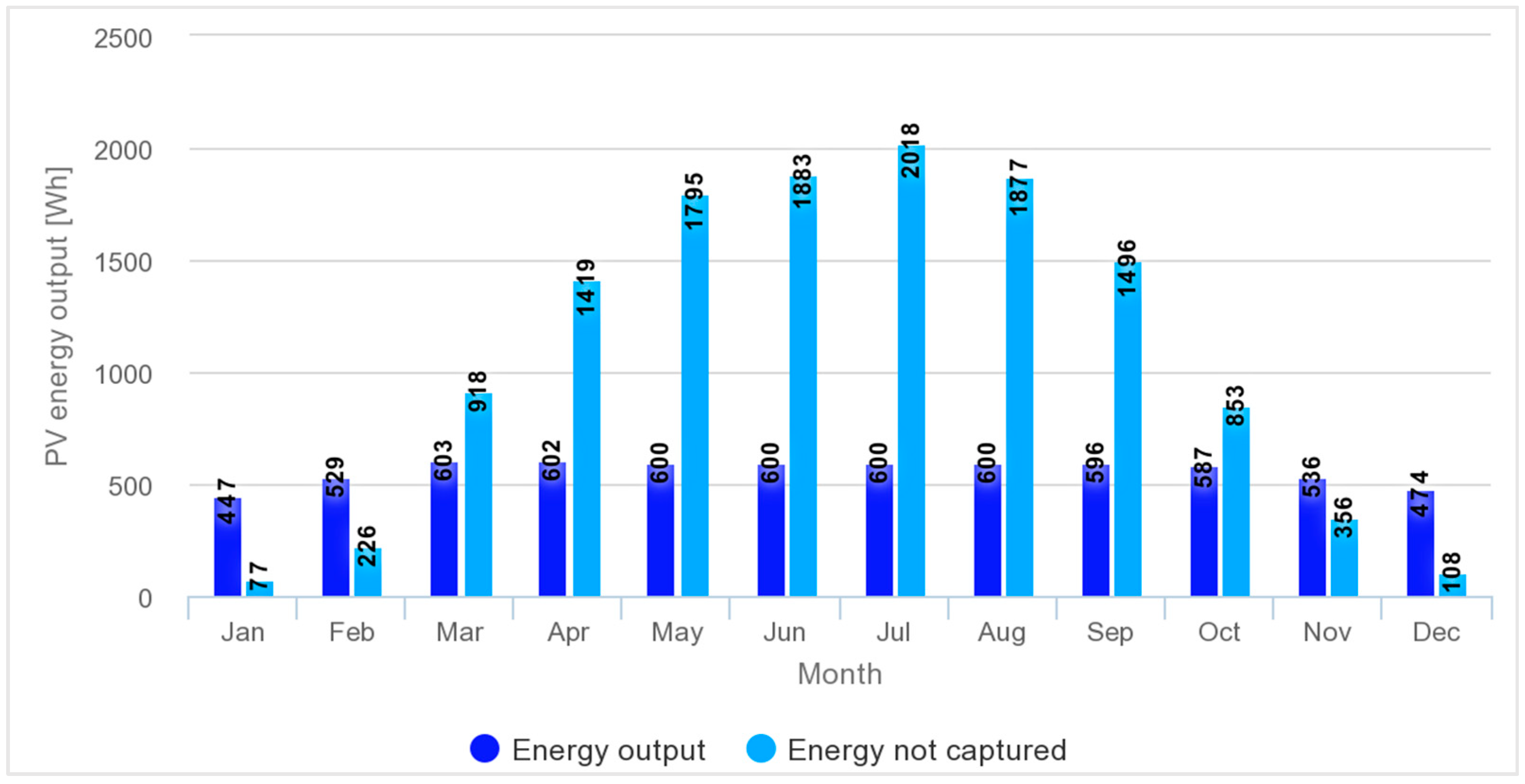

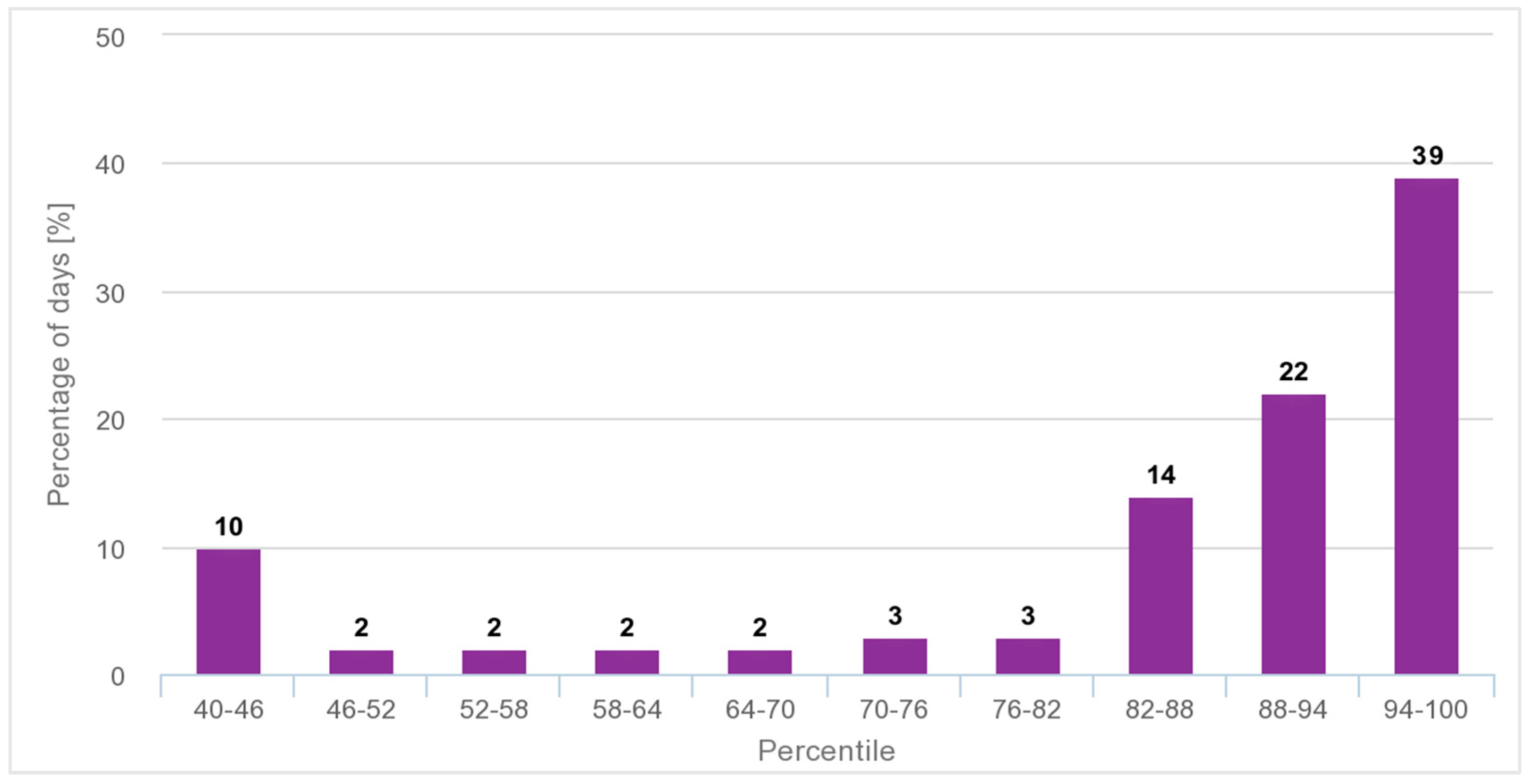
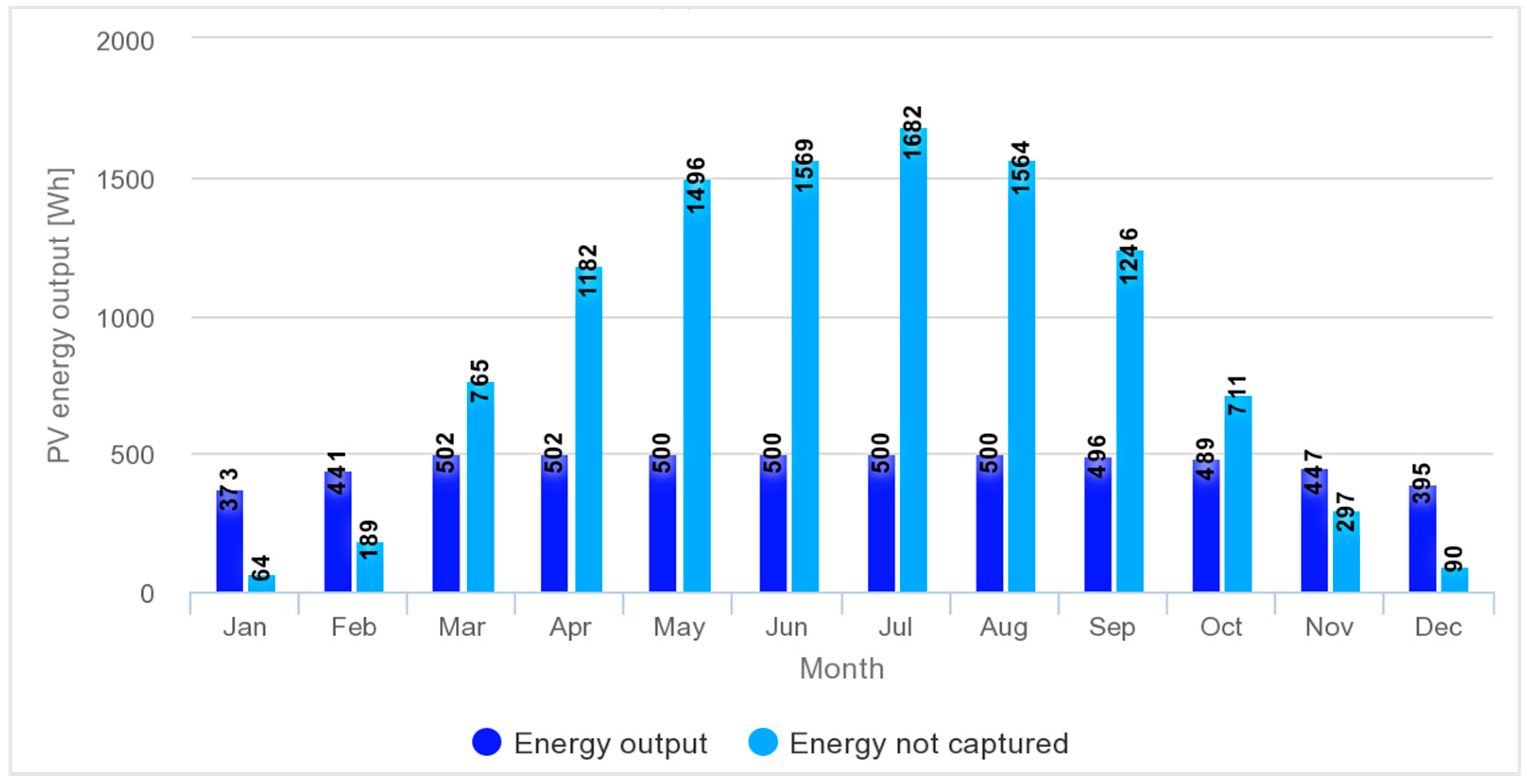
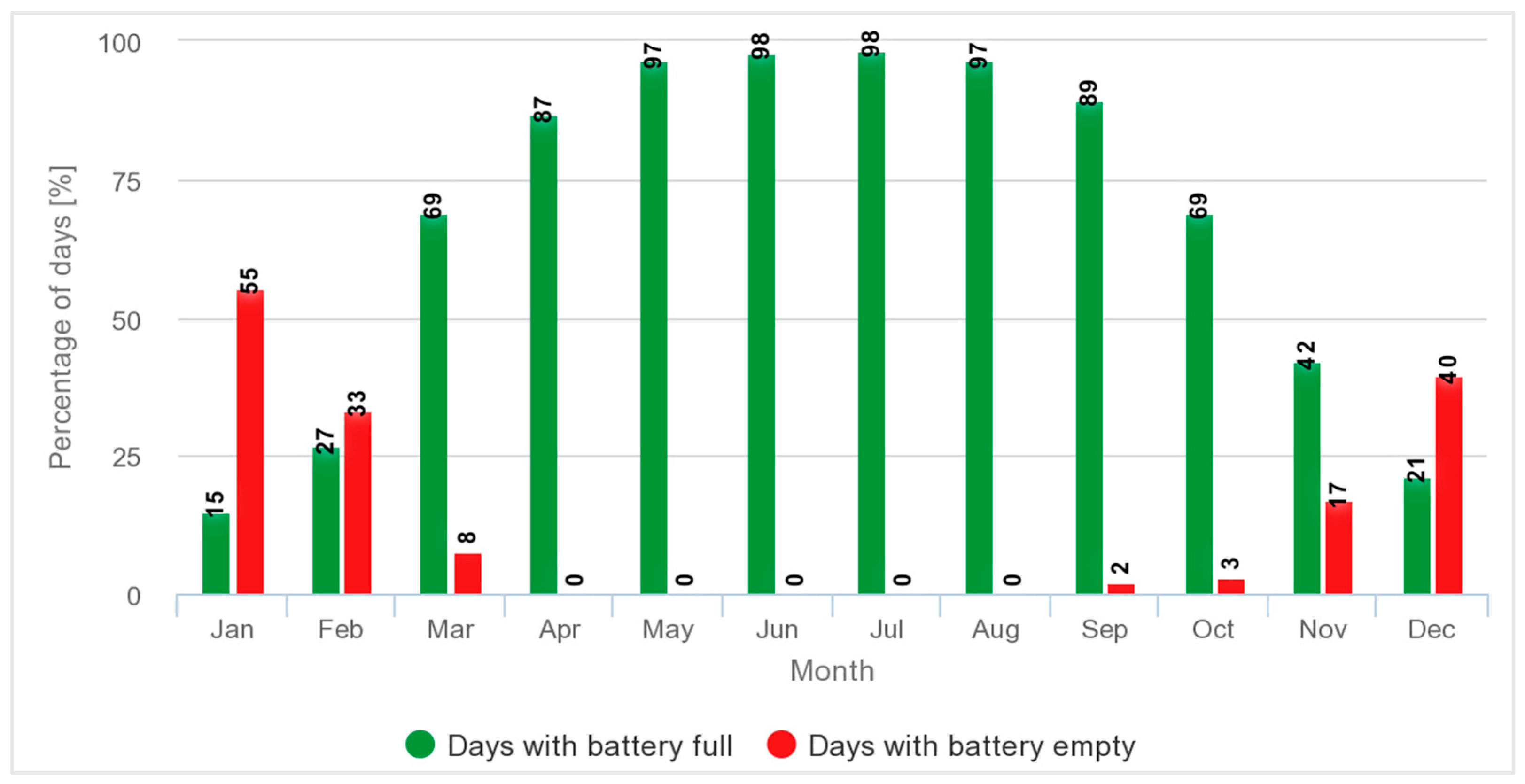
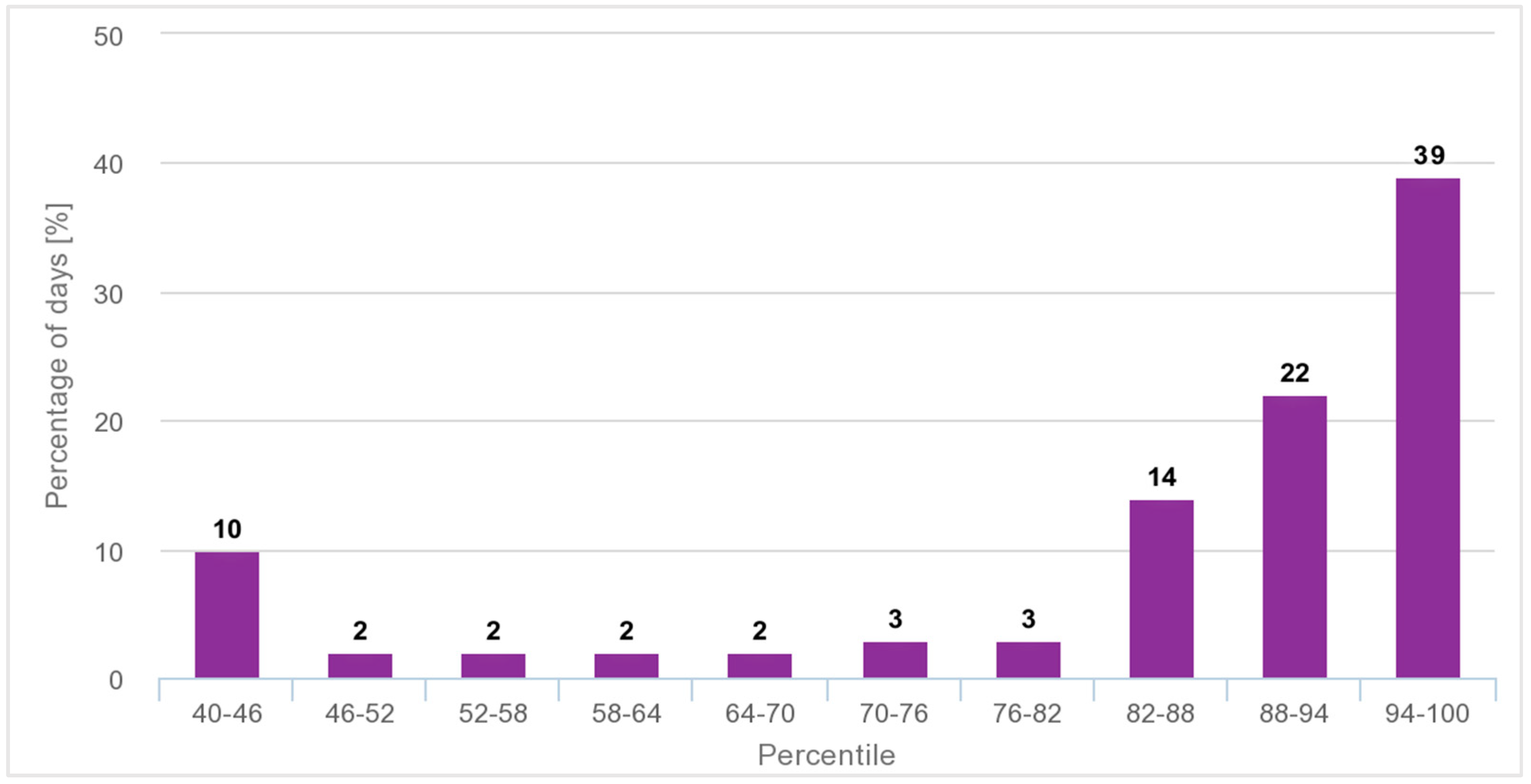
References
- Cumo, F.; Pennacchia, E.; Sferra, A.S. Sustainability in Public Lighting: The Methodology for Identifying Environmentally Optimal Solutions in Replacement Planning—A Case Study. Energies 2025, 18, 535. [Google Scholar] [CrossRef]
- European Commission. Available online: https://climate.ec.europa.eu (accessed on 23 June 2025).
- UNDP. Sustainable Street Lighting, A Guide to Efficient Public Street Lighting for Lebanon; UNDP-CEDRO Publication: New York, NY, USA, 2015. [Google Scholar]
- Alboteanu, L.; Manolea, G. Photovoltaic Panels—Solutions for a Smart City (Panourile Fotovoltaice—Soluții pentru un oraș inteligent). AGIR Bull. 2017, 1, 69–75. [Google Scholar]
- Belloni, E.; Massaccesi, A.; Moscatiello, C.; Martirano, L. Implementation of a New Solar-Powered Street Lighting System: Optimization and Technical-Economic Analysis Using Artificial Intelligence. IEEE Access 2024, 12, 46657–46667. [Google Scholar] [CrossRef]
- Omar, A.; Almaeeni, S.; Attia, H.; Takruri, M.; Altunaiji, A.; Sanduleanu, M.; Shubair, R.; Ashhab, M.S.; al Ali, M.; al Hebsi, G. Smart City: Recent Advances in Intelligent Street Lighting Systems Based on IoT. J. Sens. 2022, 2022, 5249187. [Google Scholar] [CrossRef]
- Ministry of Energy. Romania’s Energy Strategy 2016–2030, with a View to 2050; Romania Ministry of Energy: Bucharest, Romania, 2016. [Google Scholar]
- Available online: https://www.transelectrica.ro/en/web/tel/home (accessed on 23 June 2025).
- National Energy Regulatory Authority. Report on the Results of the Electricity Market Monitoring in December 2023; National Energy Regulatory Authority: Ljubljana, Slovenia, 2023.
- Sustainable Street Lighting, Brighter Cities, Brighter Future. The Conoler Series. Available online: www.econoler.com (accessed on 23 June 2025).
- Velásquez, C.; Espín, F.; Castro, M.Á.; Rodríguez, F. Energy Efficiency in Public Lighting Systems Friendly to the Environment and Protected Areas. Sustainability 2024, 16, 5113. [Google Scholar] [CrossRef]
- Lv, Z.; Guo, H.; Zhang, L.; Liang, D.; Zhu, Q.; Liu, X.; Zhou, H.; Liu, Y.; Gou, Y.; Dou, X.; et al. Urban public lighting classification method and analysis of energy and environmental effects based on SDGSAT-1 glimmer imager data. Appl. Energy 2024, 355, 122355. [Google Scholar] [CrossRef]
- Molina-Moreno, V.; Utrilla, P.N.C.; Cortés-García, F.J.; Peña-García, A. The use of led technology and biomass to power public lighting in a local context: The case of baeza (Spain). Energies 2018, 11, 1783. [Google Scholar] [CrossRef]
- Meflah, A.; Chekired, F.; Drir, N.; Canale, L. Accurate Method for Solar Power Generation Estimation for Different PV (Photovoltaic Panels) Technologies. Resources 2024, 13, 166. [Google Scholar] [CrossRef]
- Available online: https://sdgs.un.org/goals/goal7 (accessed on 23 June 2025).
- Sorooshian, S. The sustainable development goals of the United Nations: A comparative midterm research review. J. Clean. Prod. 2024, 453, 142272. [Google Scholar] [CrossRef]
- Tavares, P.; Ingi, D.; Araújo, L.; Pinho, P.; Bhusal, P. Reviewing the Role of Outdoor Lighting in Achieving Sustainable Development Goals. Sustainability 2021, 13, 12657. [Google Scholar] [CrossRef]
- Valetti, L.; Piccablotto, G.; Taraglio, R.; Pellegrino, A. Long-Term Monitoring Campaign of LED Street Lighting Systems: Focus on Photometric Performances, Maintenance and Energy Savings. Sustainability 2023, 15, 16910. [Google Scholar] [CrossRef]
- Jettanasen, C.; Ngaopitakkul, A. Characteristics and Effects of Conducted Emission from Grid-Connected and Stand-Alone Micro-Inverters in a Nano-Grid Road Lighting System. Sustainability 2019, 11, 5690. [Google Scholar] [CrossRef]
- Pardo-Bosch, F.; Blanco, A.; Sesé, E.; Ezcurra, F.; Pujadas, P. Sustainable strategy for the implementation of energy efficient smart public lighting in urban areas: Case study in San Sebastian. Sustain. Cities Soc. 2022, 76, 103454. [Google Scholar] [CrossRef]
- Bian, J.; Yang, J.J. Smart Street Lighting Powered by Renewable Energy: A Multi-Criteria, Data-Driven Decision Framework. Sustainability 2025, 17, 5874. [Google Scholar] [CrossRef]
- Canale, L.; Hamady, M. History of Artificial Lighting, from Fire to LED [History]. IEEE Ind. Appl. Mag. 2025, 31, 10–25. [Google Scholar] [CrossRef]
- Faustino, R.; Lameirinhas, R.A.M.; Bernardo, C.P.C.V.; Torres, J.P.N.; Santos, M. Study of the application of solar cells in public lighting. Int. J. Innov. Res. Sci. Stud. 2025, 8, 543–559. [Google Scholar] [CrossRef]
- Allery, T.A.; Martino, A.; Begay, S. Solar Street Lighting: Using Renewable Energy for Safety for the Turtle Mountain Band of Chippewa. 2018. Available online: https://www.energy.gov/sites/prod/files/2018/11/f57/Allery-2018-solar-street-lighting.pdf (accessed on 23 June 2025).[Green Version]
- Ocana-Miguel, A.; Gago-Calderon, A.; Andres-Diaz, J.R. Experimental Outdoor Public Lighting Installation Powered by a Hydraulic Turbine Installed in the Municipal Water Supply Network. Water 2022, 14, 710. [Google Scholar] [CrossRef]
- Slimene, M.B.; Arbi Khlifi, M. Modelling and study of energy storage devices for photovoltaic lighting. Energy Explor. Exploit. 2020, 38, 1932–1945. [Google Scholar] [CrossRef]
- Zerari, H.; Messikh, L.; Kouzou, A.; Ouchtati, S. Smart energy management and monitoring system for public lighting system based on photovoltaic and storage systems. Electroteh. Electron. Autom. (EEA) 2021, 69, 5–10. [Google Scholar] [CrossRef]
- Baburajan, S.; Amin, F.; Zarooni, A.; Osman, A. Solar-powered LED Street Lighting System Case Study-American University of Sharjah, UAE. Saudi J. Eng. Technol. 2017, 2, 49–56. [Google Scholar] [CrossRef]
- Simanjuntak, I.U.V.; Dani, A.W.; Salamah, K.S.; Silalahi, L.M. Analysis of solar power public street lighting optimization with Pvsyst software in a residential complex area. Int. J. Electron. Telecommun. 2024, 70, 743–749. [Google Scholar] [CrossRef]
- Junisbekov, M.; Grigoryev, D.; Tolganbayeva, M.; Turgynbekov, Y.; Omirbekova, Z. Design, Simulation, and Analysis of a Solar-Powered Street Lighting Control System for Power Consumption Prediction. Preprints 2024, 2024120003. [Google Scholar] [CrossRef]
- Wang, Q.; Jiang, B.; Li, B.; Yan, Y. A critical review of thermal management models and solutions of lithium-ion batteries for the development of pure electric vehicles. Renew. Sustain. Energy Rev. 2016, 64, 106–128. [Google Scholar] [CrossRef]
- Kalkan, O.; Celen, A.; Bakirci, K. Experimental and numerical investigation of the LiFePO4 battery cooling by natural convection. J. Energy Storage 2021, 40, 102796. [Google Scholar] [CrossRef]
- Orejon-Sanchez, R.D.; Andres-Diaz, J.R.; Gago-Calderon, A. Autonomous photovoltaic led urban street lighting: Technical, economic, and social viability analysis based on a case study. Sustainability 2021, 13, 11746. [Google Scholar] [CrossRef]
- Pratama, S.G.; Namyra Alissa, R.A.D.; Nafis, R.F.; Arrayyan, A.Z.; Putra, K.T. Implementation and Feasibility Study of Solar-powered Streetlighting Systems in Rural Community Area. E3S Web Conf. 2023, 425, 05007. [Google Scholar] [CrossRef]
- M’hamed, R.; Boussemaha, B.; Mouaadh, Y.; Youcef, H.; Mohammed, D. Low cost of smart unilateral street lighting system with photovoltaic power plant using particle swarm optimization. Stud. Eng. Exact Sci. 2024, 5, e11658. [Google Scholar] [CrossRef]
- Liu, G. Sustainable feasibility of solar photovoltaic powered street lighting systems. Int. J. Electr. Power Energy Syst. 2014, 56, 168–174. [Google Scholar] [CrossRef]
- Sadeghian, O.; Mohammadi-Ivatloo, B.; Oshnoei, A.; Aghaei, J. Unveiling the potential of renewable energy and battery utilization in real-world public lighting systems: A review. Renew. Sustain. Energy Rev. 2024, 192, 114241. [Google Scholar] [CrossRef]
- Vargas-Salgado, C.; Montagud-Montalvá, C.; Alfonso-Solar, D.; Izquierdo-De-Andrés, L. Toward Carbon Neutrality: A Methodological Approach for Assessing and Mitigating Urban Emissions at the Neighborhood Level, Applied to Benicalap, Valencia. Sustainability 2025, 17, 5150. [Google Scholar] [CrossRef]
- Duman, A.C.; Güler, Ö. Techno-economic analysis of off-grid photovoltaic LED road lighting systems: A case study for northern, central and southern regions of Turkey. Build. Environ. 2019, 156, 89–98. [Google Scholar] [CrossRef]
- NP 062-2002; Norm for the Design of Road and Pedestrian Lighting Systems. MDPLA: Bucharest, Romania, 2002.
- EN 13201-1; 2015 Public Lighting—Part 1. Selection of Lighting Classes. CEN: Brussels, Belgium, 2016.
- EN 13201-2; 2016 Public Lighting—Part 2: Performance Requirements. CEN: Brussels, Belgium, 2016.
- EN 13201-3; 2016 Public Lighting—Part 3: Calculation of Performance. CEN: Brussels, Belgium, 2016.
- EN 13201-4; 2016 Public Lighting—Part 4: Methods for Measuring Photometric Performance. CEN: Brussels, Belgium, 2016.
- EN 13201-5; 2016 Public Lighting—Part 5: Energy Performance Indicators. CEN: Brussels, Belgium, 2016.
- European Union. Directive 2003/87/EC of the European Parliament and of the Council of 13 October 2003 Establishing a Scheme for Greenhouse Gas Emission Allowance Trading Within the Community and Amending Council Directive 96/61/EC; EU: Brussels, Belgium, 2003. [Google Scholar]
- Ciobanu, I. Increasing Energy Efficiency in Modern PUBLIC Lighting Systems (Creșterea Eficienței Energetice în Sistemele de Iluminat Public Moderne). Ph.D. Thesis, Polytechnic University of Bucharest, Bucharest, Romania, 2022. [Google Scholar]
- Available online: www.ro-electrice.ro (accessed on 23 June 2025).
- PE 136-1988; Republican Regulation for the Rational Use of Electricity in Artificial Lighting and Domestic Uses. Ministry of Development, Public Works and Administration: Bucharest, Romania, 1988.
- DIALux Evo. Lighting Design Software for Individual Rooms, Entire Buildings, Streets, Outdoor Areas and Emergency Lighting. Available online: https://www.dialux.com/en-GB/download (accessed on 23 June 2025).
- ORDER No. 49 of January 27, 1998: Technical Norms Regarding the Design, Construction and Modernization of Roads. Available online: https://legislatie.just.ro/Public/DetaliiDocument/15882 (accessed on 23 June 2025).
- Shahzad, K.; Čuček, L.; Sagir, M.; Ali, N.; Rashid, M.I.; Nazir, R.; Nizami, A.S.; Al-Turaif, H.A.; Ismail, I.M.I. An ecological feasibility study for developing sustainable street lighting system. J. Clean. Prod. 2018, 175, 683–695. [Google Scholar] [CrossRef]
- Available online: www.energyprod.ro (accessed on 23 June 2025).
- Photovoltaic Geographial Information System (PVGIS). Available online: https://re.jrc.ec.europa.eu (accessed on 23 June 2025).
- Aitio, A.; Howey, D.A. Predicting battery end of life from solar off-grid system field data using machine learning. Joule 2021, 5, 3204–3220. [Google Scholar] [CrossRef]
- Available online: www.depozitsolar.ro (accessed on 23 June 2025).
- Skandali, C.; Zerefos, S.; Tsangrassoulis, A.; Peña-García, A.; Triantafyllidis, G.A.; Zissis, G.; Doulos, L.T. Reviewing the parameters that affect sustainability and energy efficient concepts in road and urban lighting design. J. Clean. Prod. 2025, 490, 144607. [Google Scholar] [CrossRef]
- GEO 27-2022 Regarding the Measures Applicable to Final Customers in the Electricity and Natural Gas Market, as Well as for Amending and Supplementing Certain Normative Acts in the Energy Field. Available online: https://www.correggionet.eu/wp-content/uploads/2022/03/GEO-272022_EN.pdf (accessed on 23 June 2025).
- Available online: www.generatoare-solare.ro (accessed on 23 June 2025).
- European Comission. Commission Regulation (EU) No 601/2012 of 21 June 2012 on the monitoring and reporting of greenhouse gas emissions pursuant to Directive 2003/87/EC of the European Parliament and of the Council. Off. J. Eur. Union 2012, 181, 30–104. [Google Scholar]
- Available online: www.e-acumulatori.ro (accessed on 23 June 2025).
- Available online: www.electric14.ro (accessed on 23 June 2025).
- Available online: www.schrack.ro (accessed on 23 June 2025).
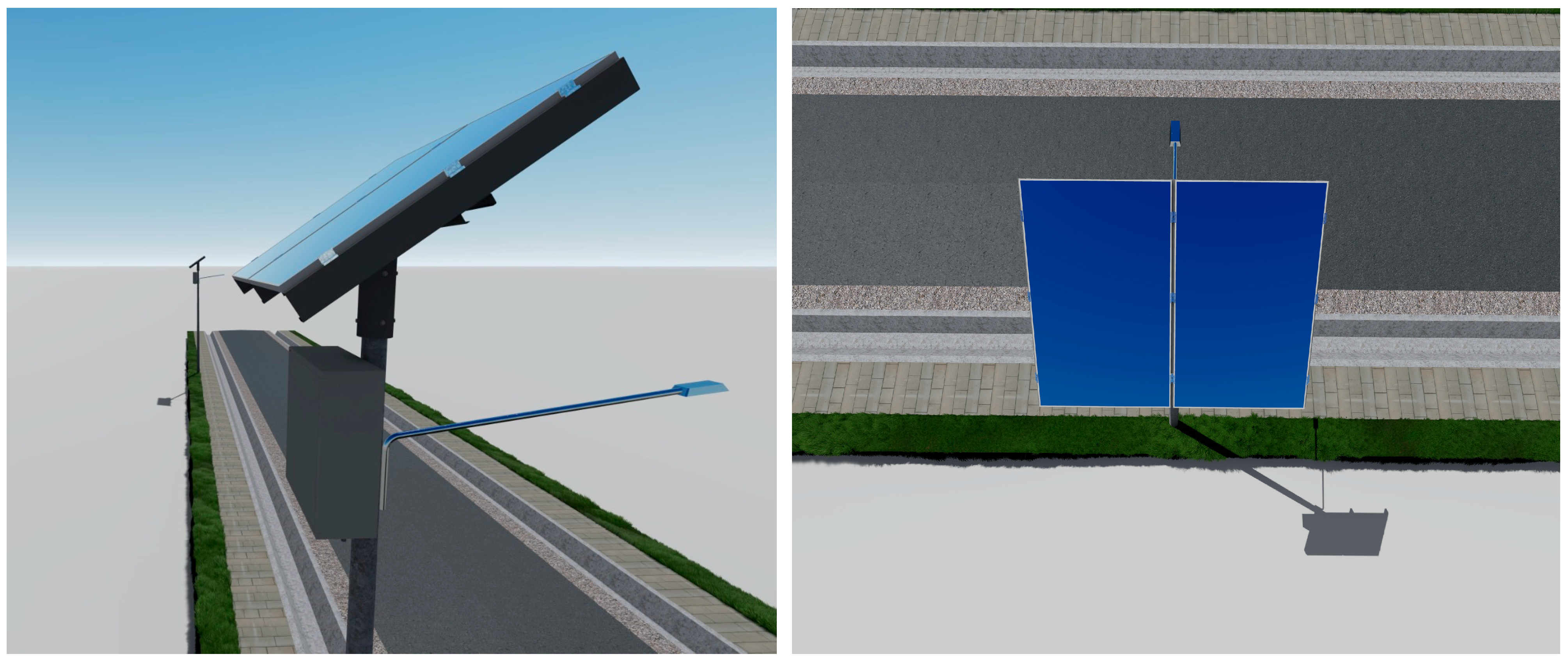
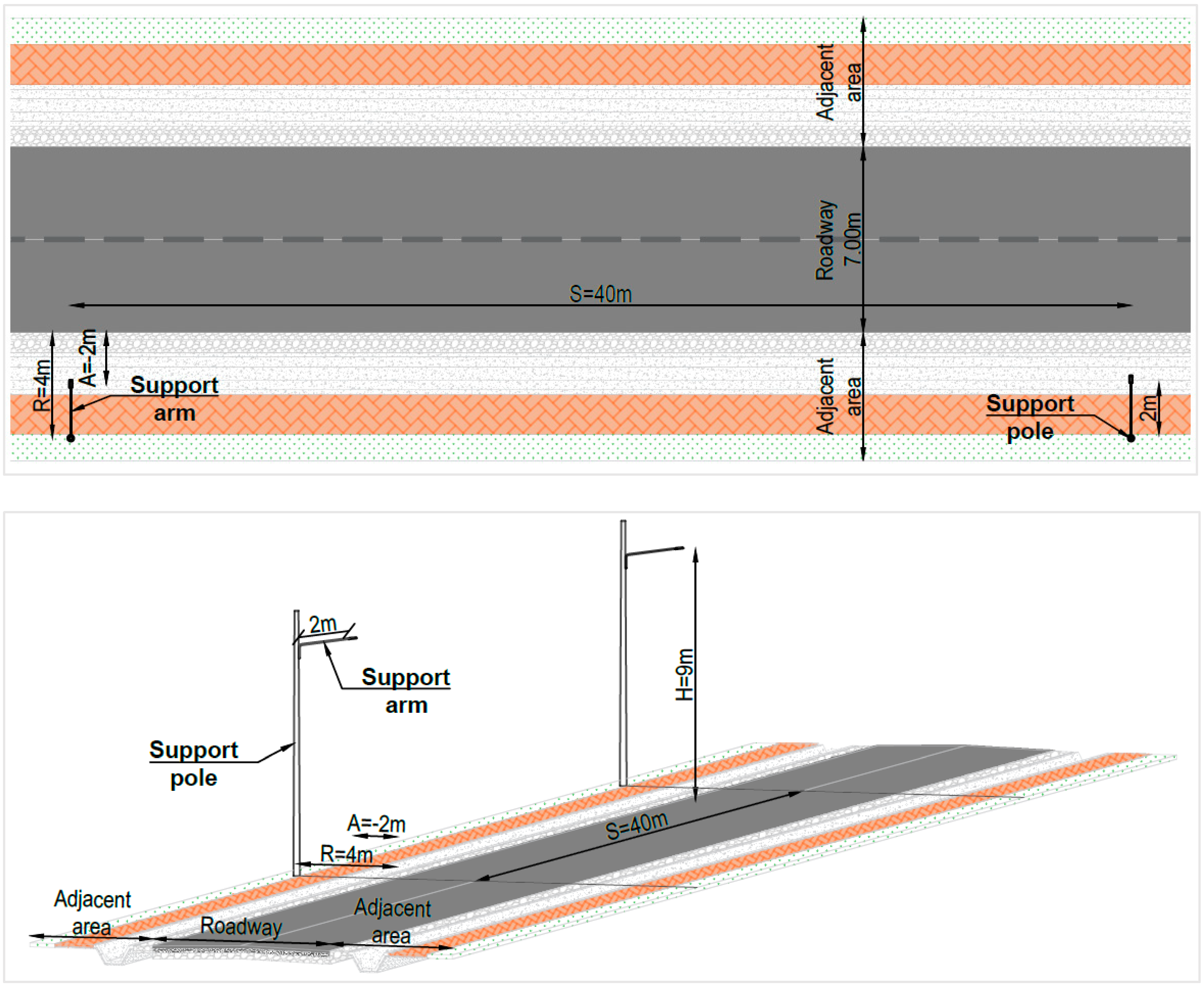


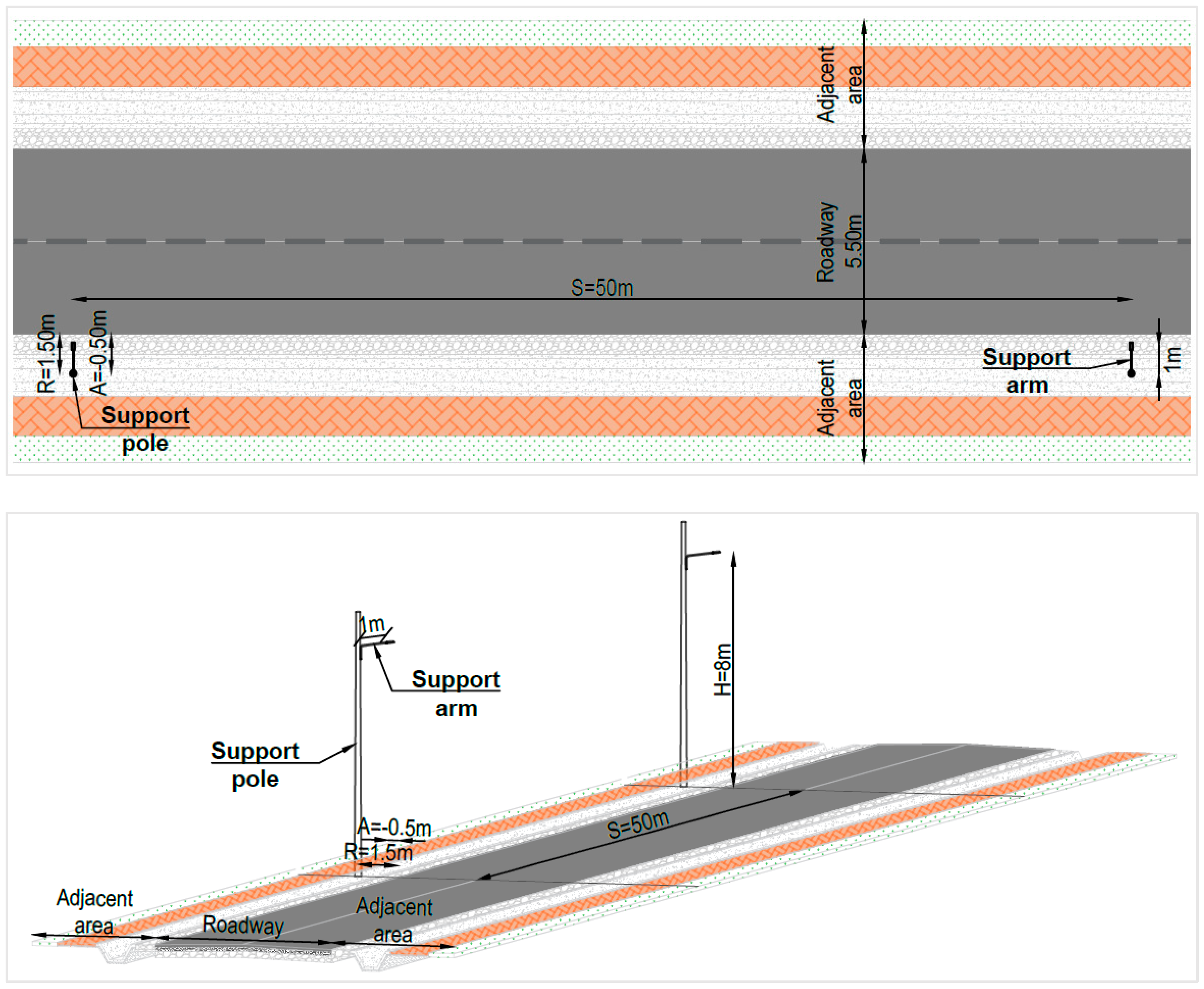


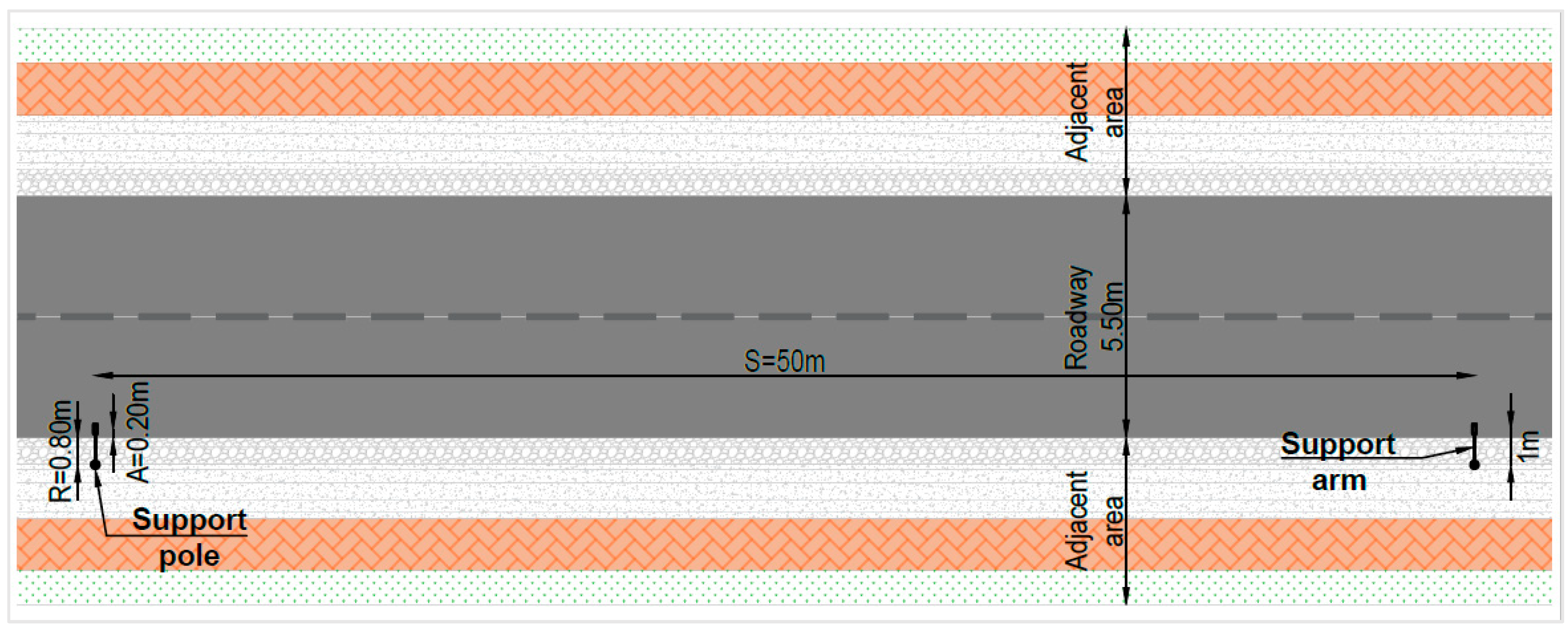
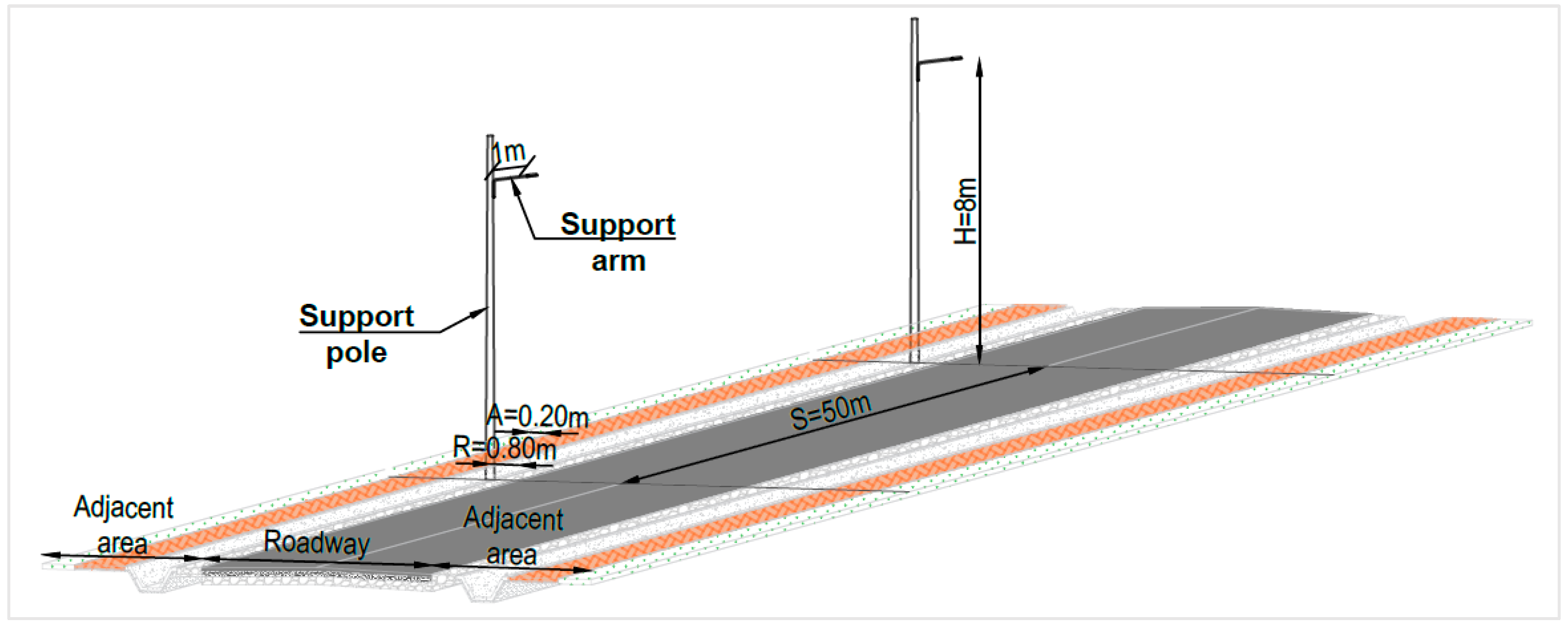


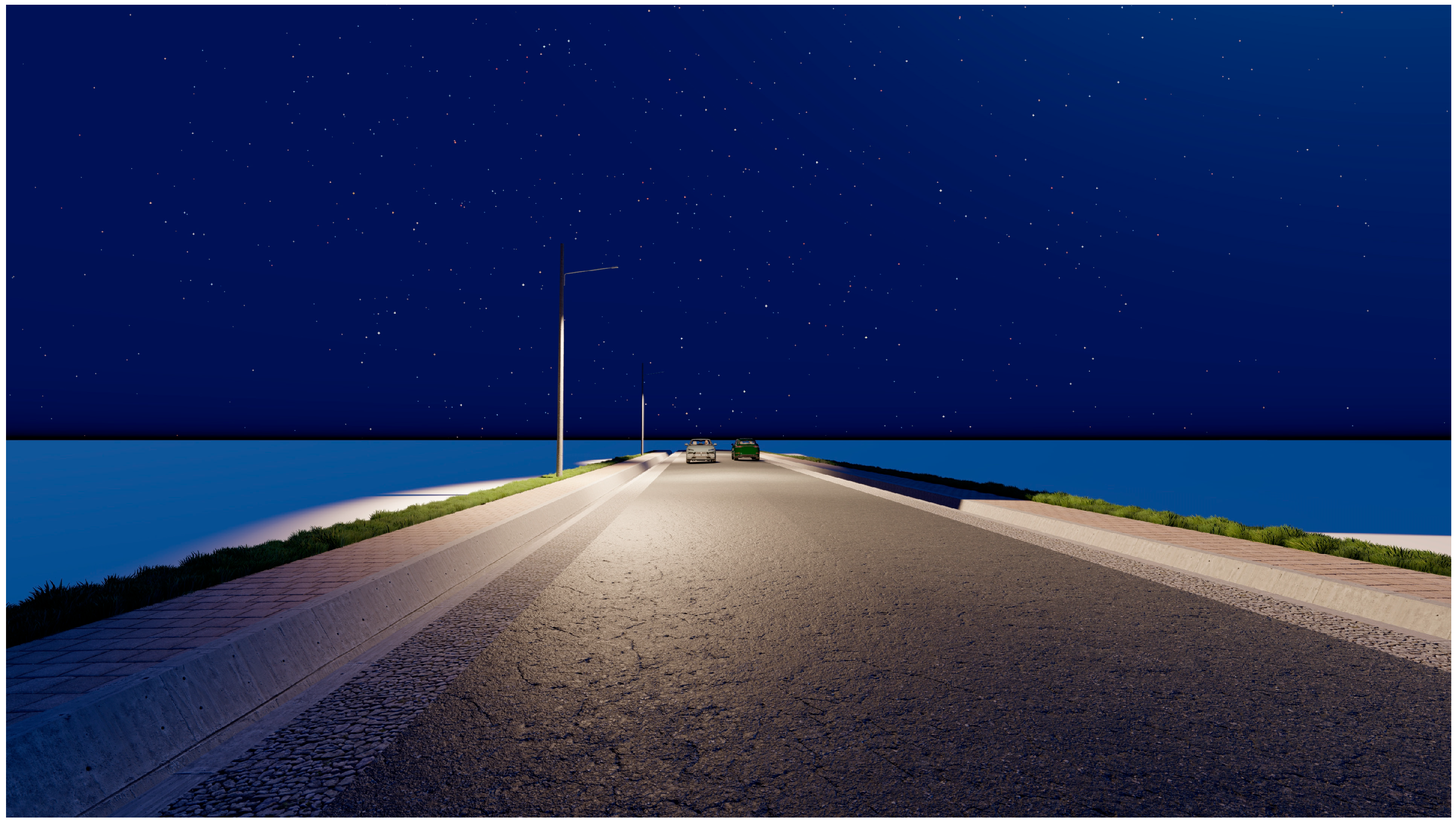
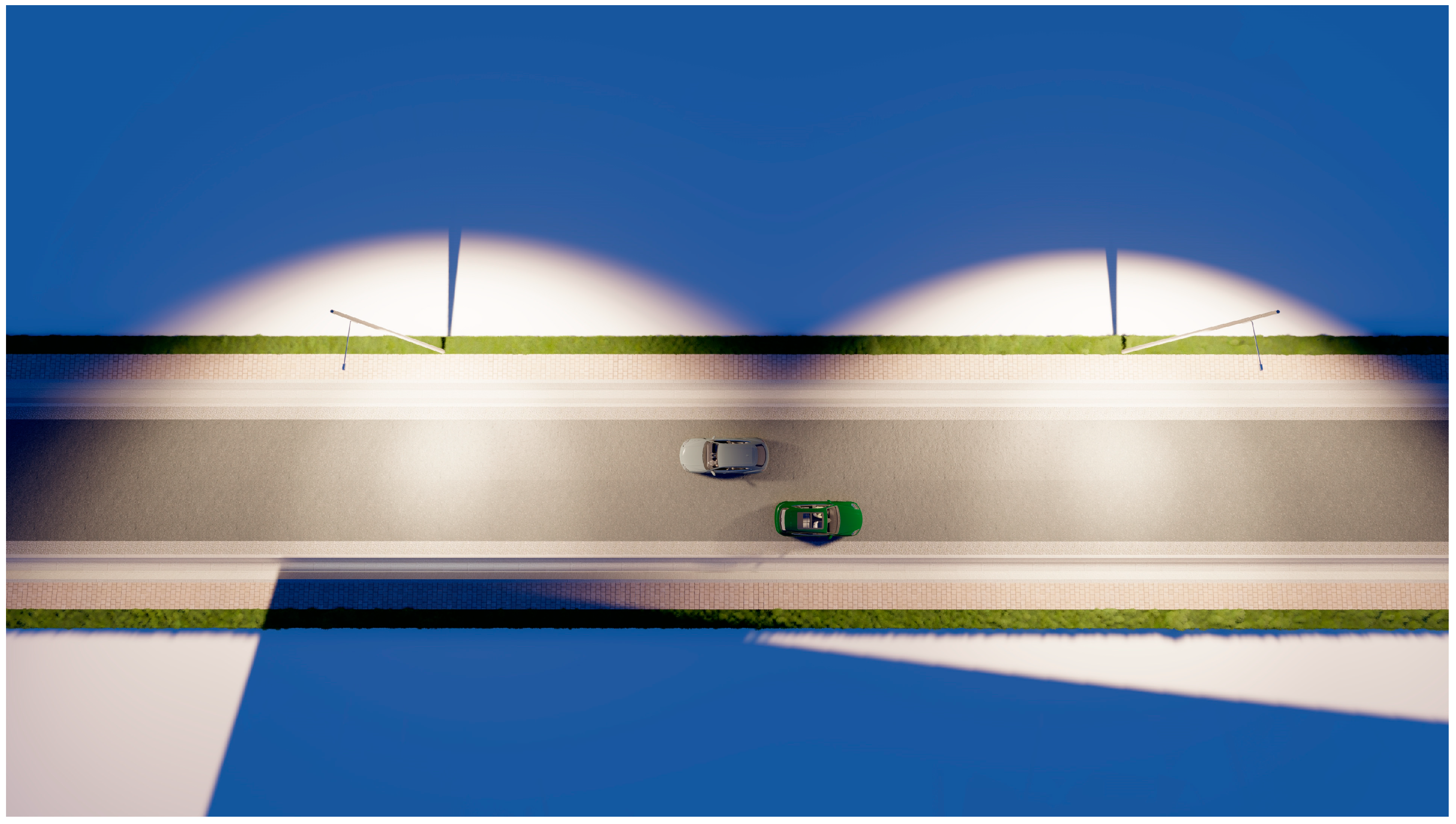
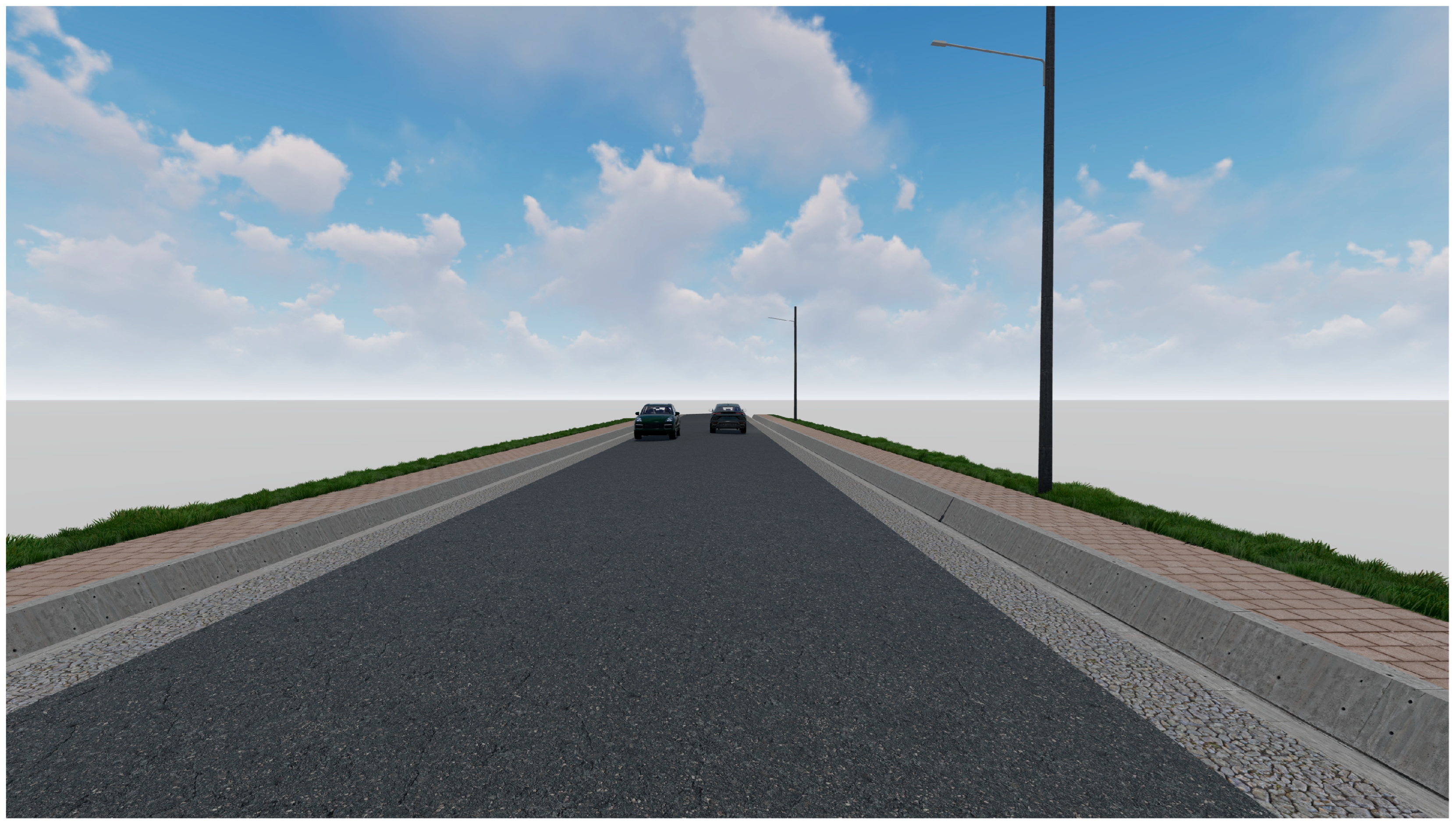
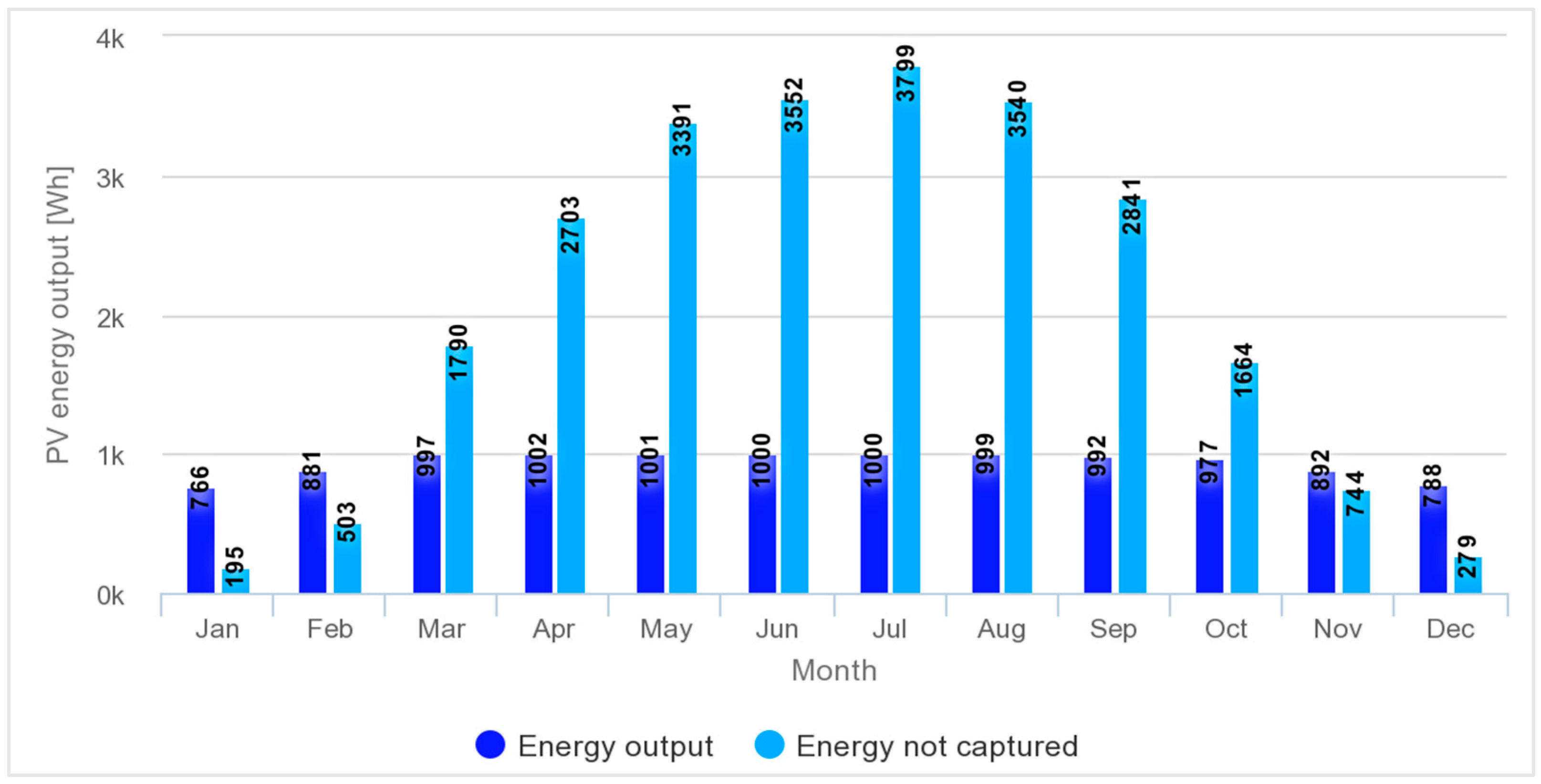
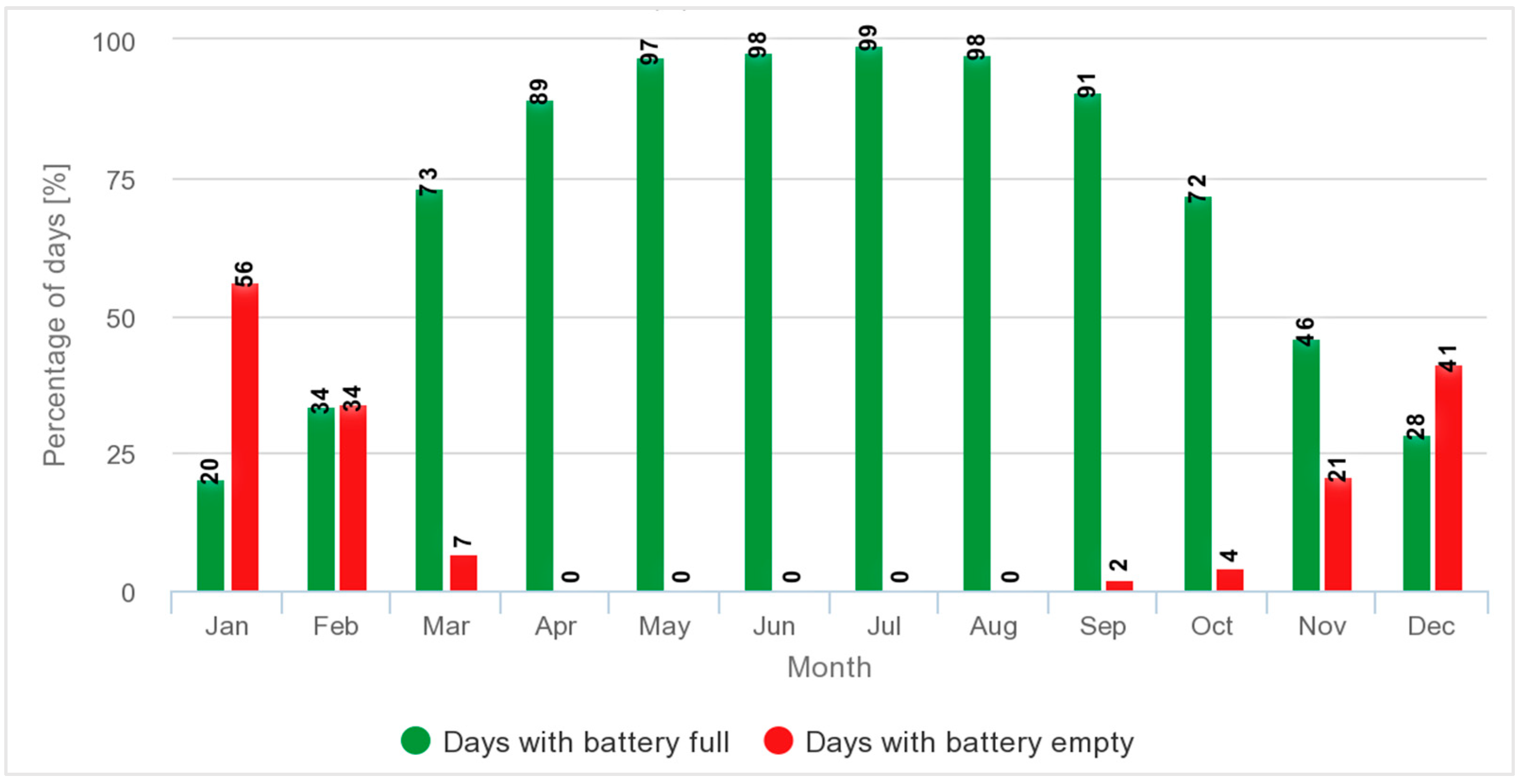
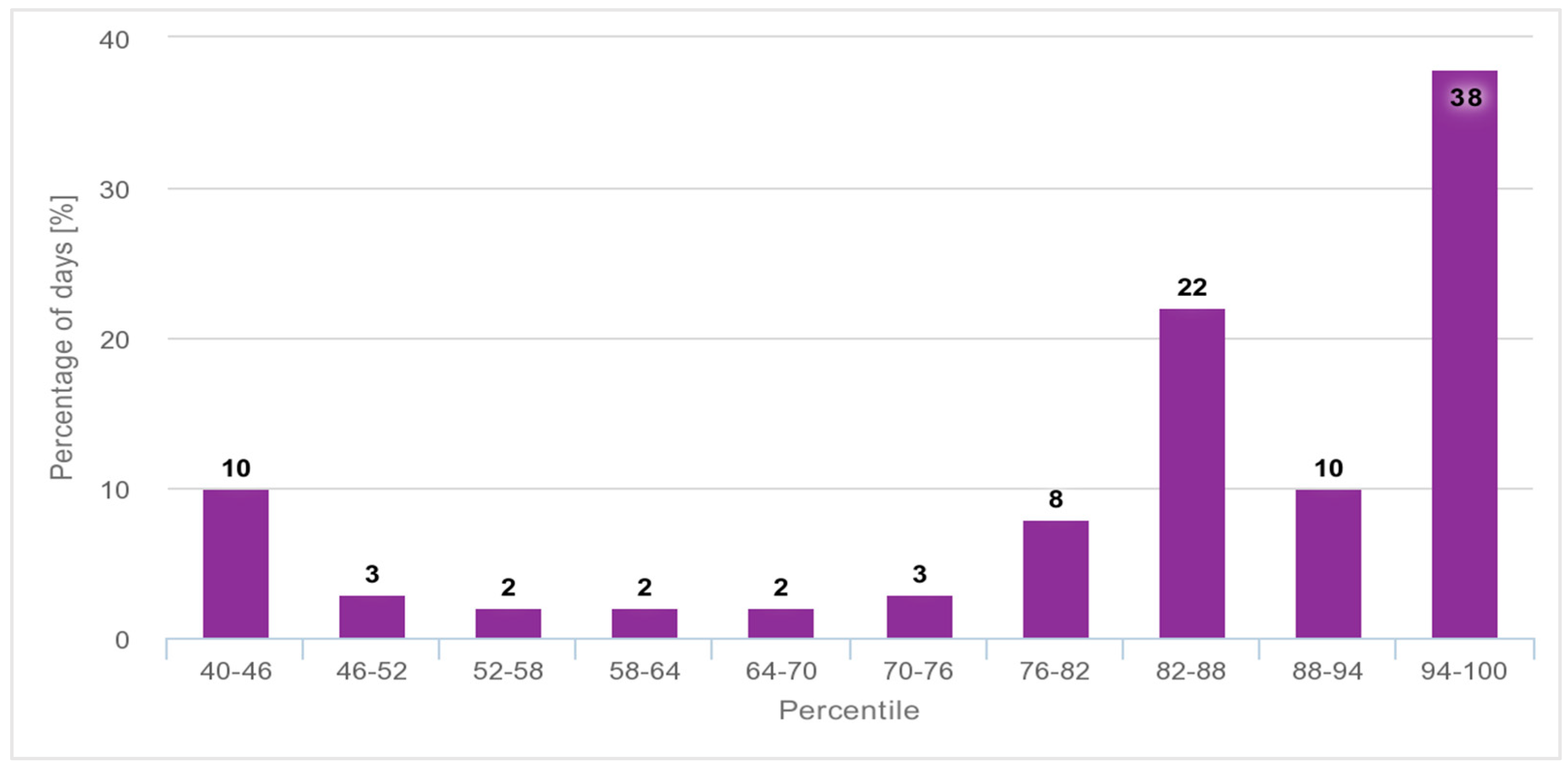
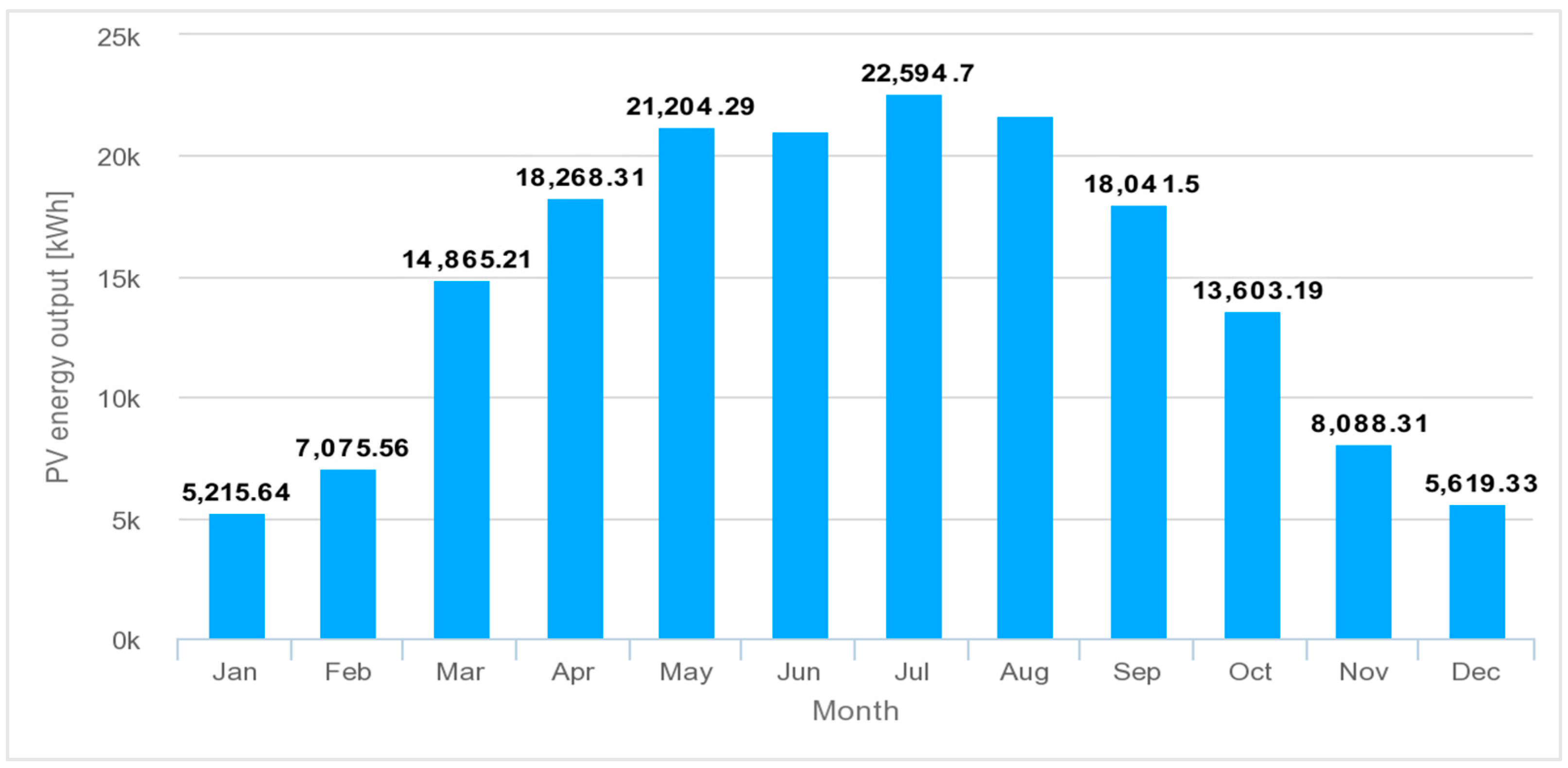
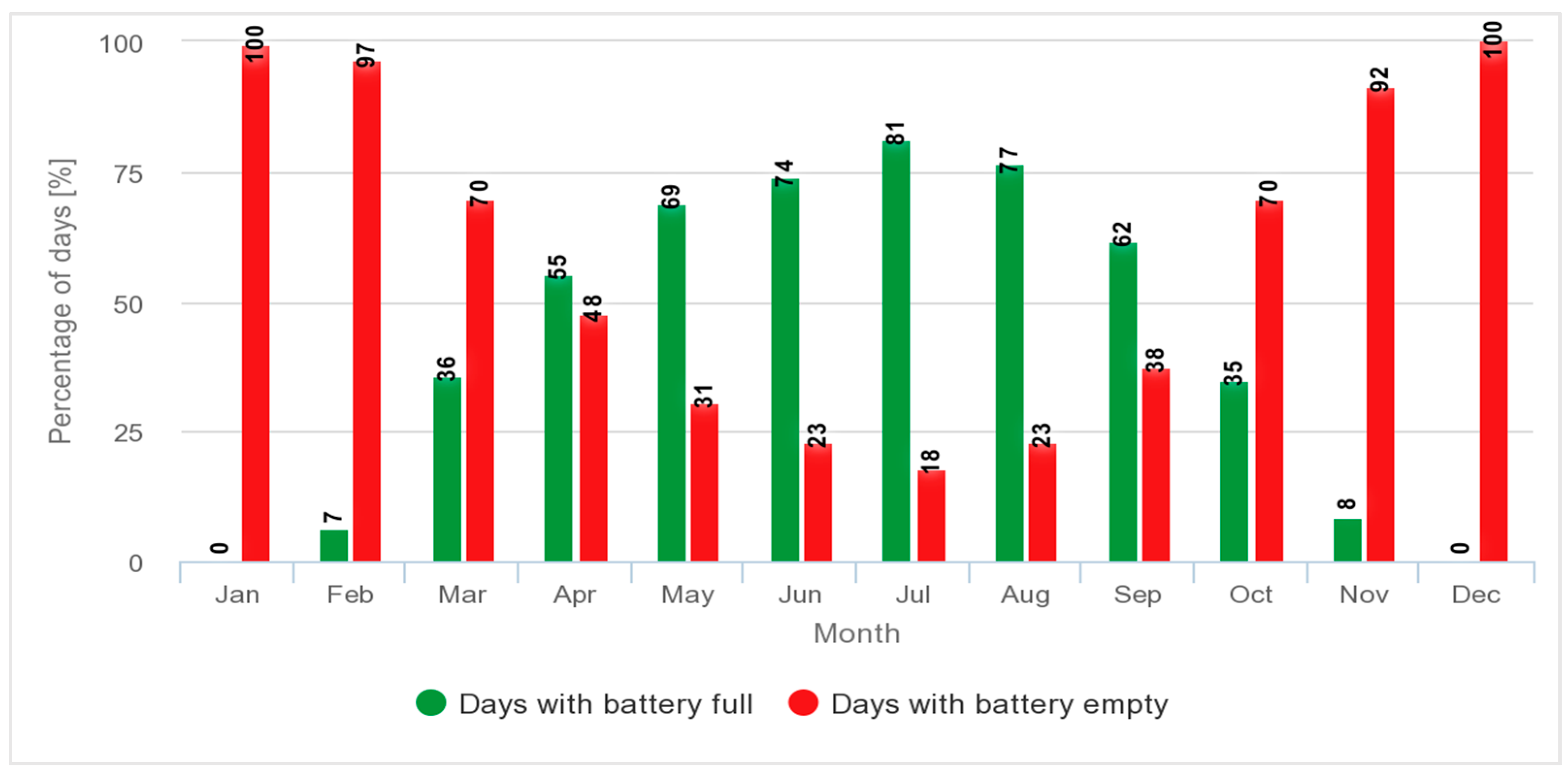
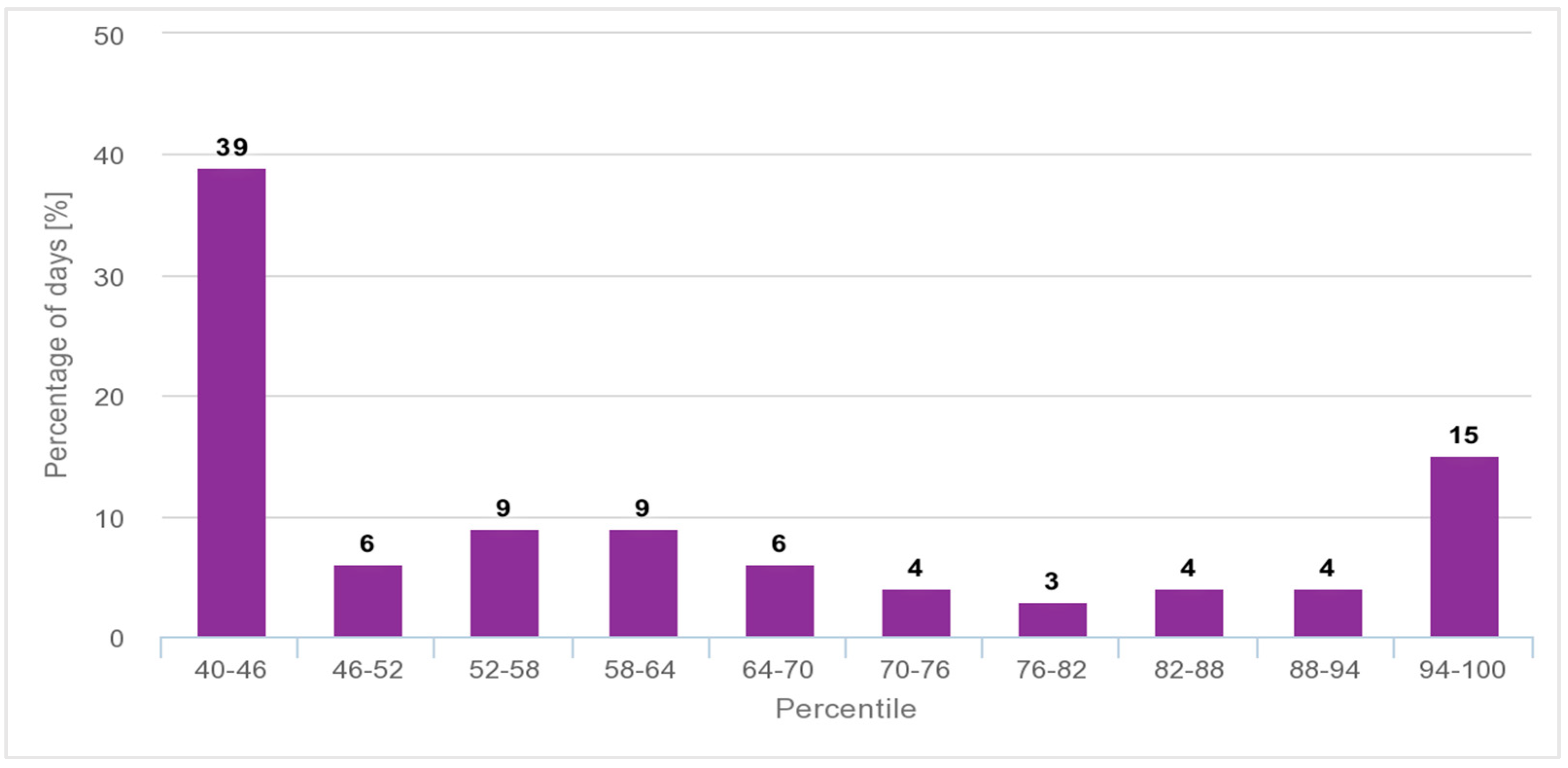
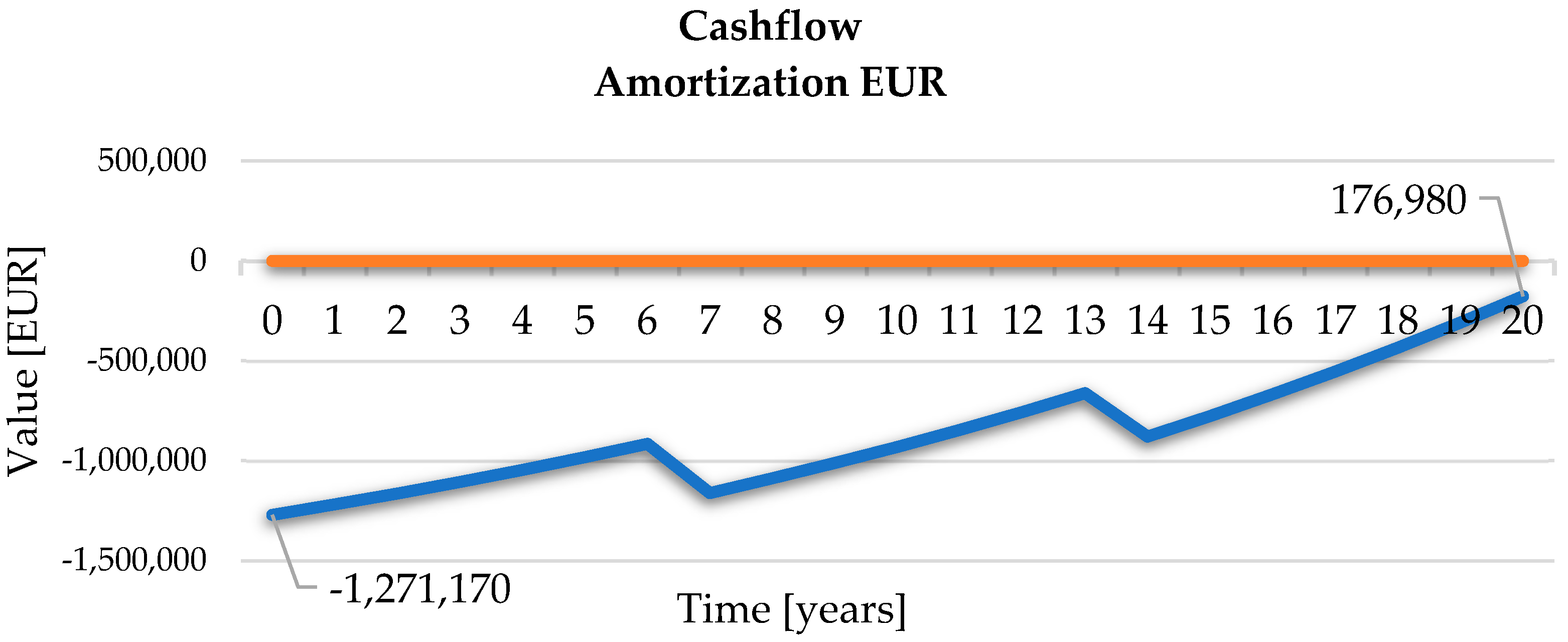

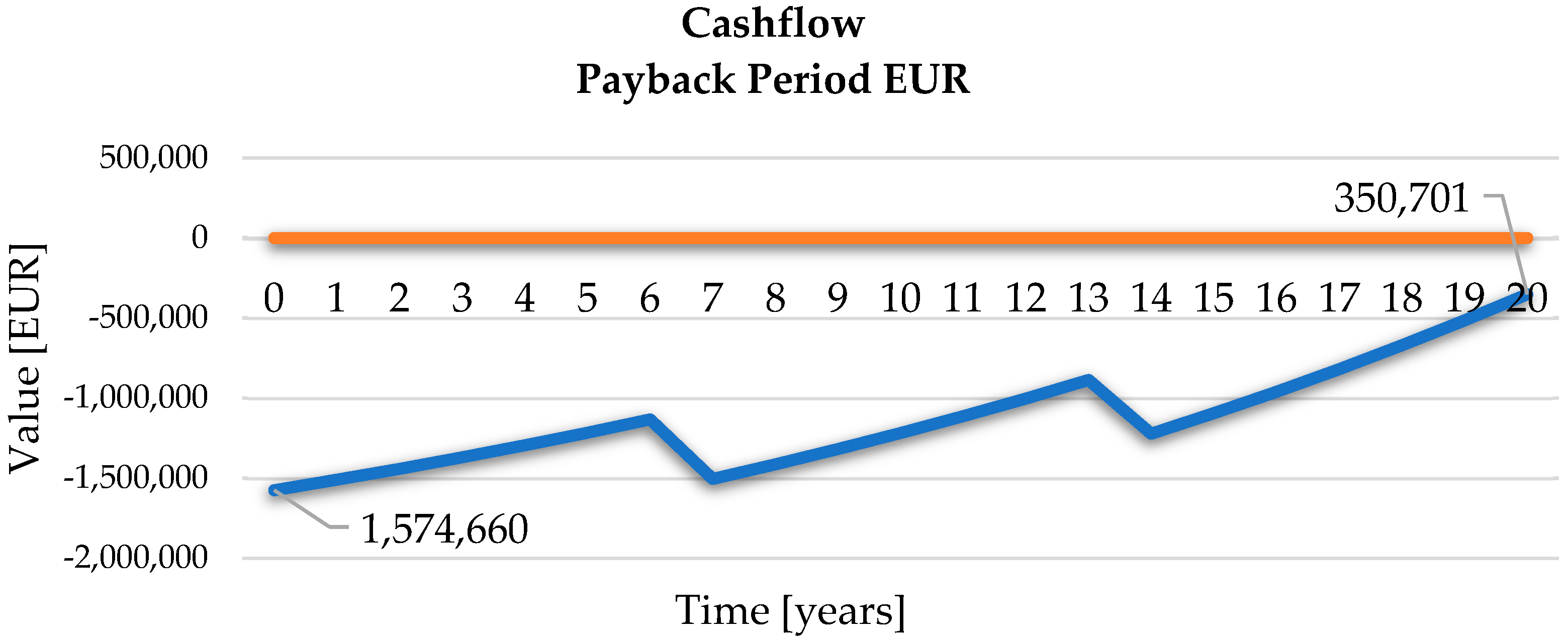
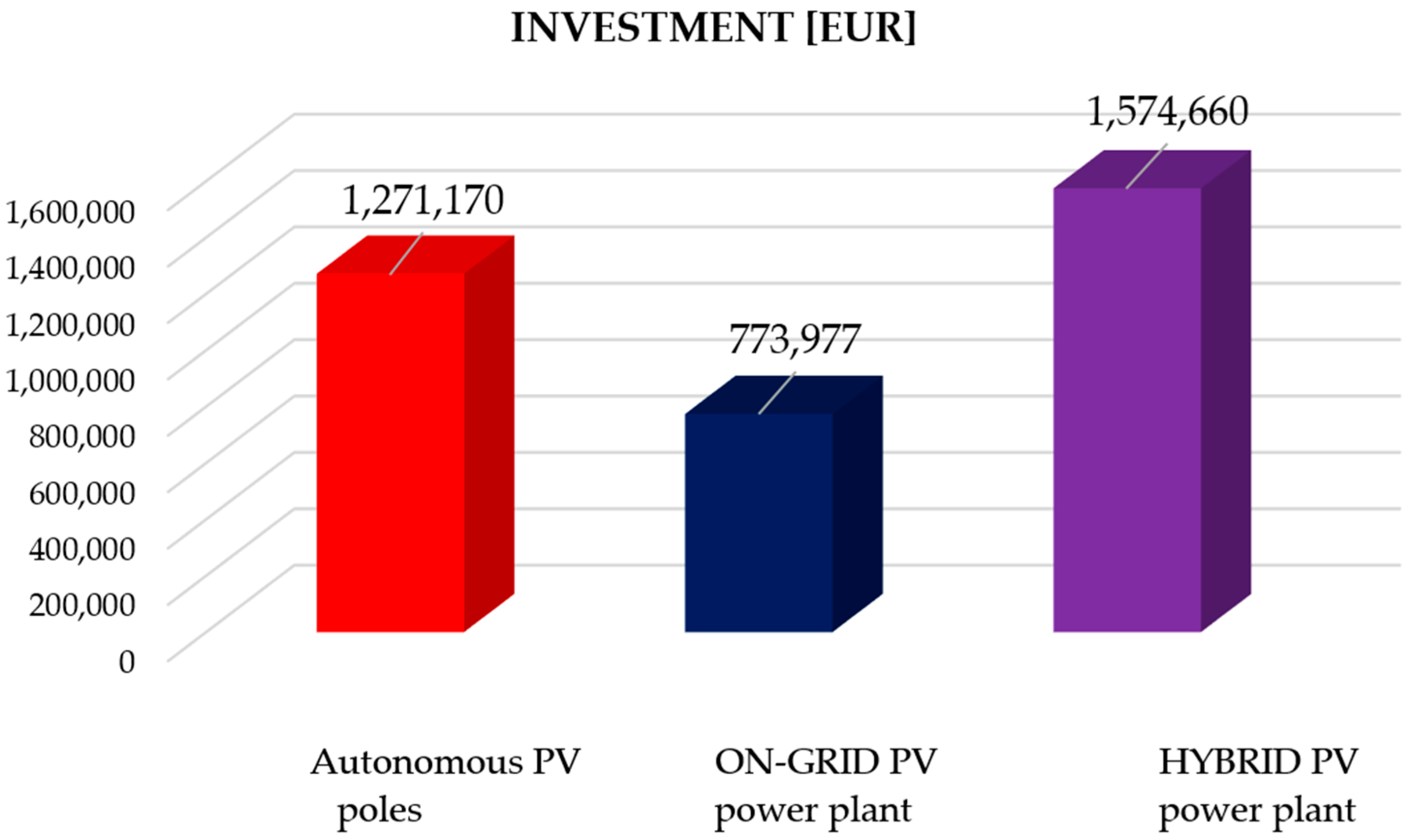

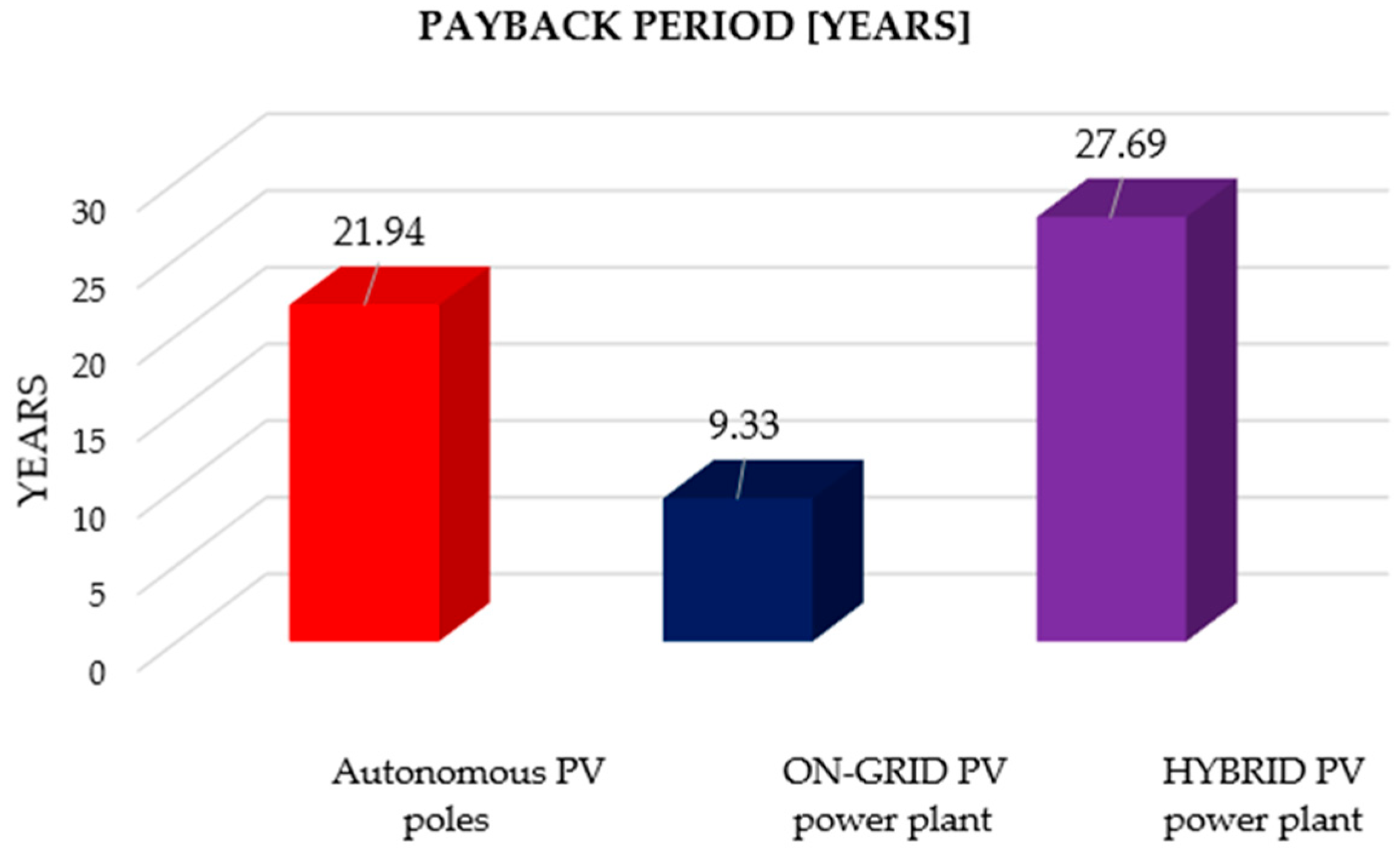
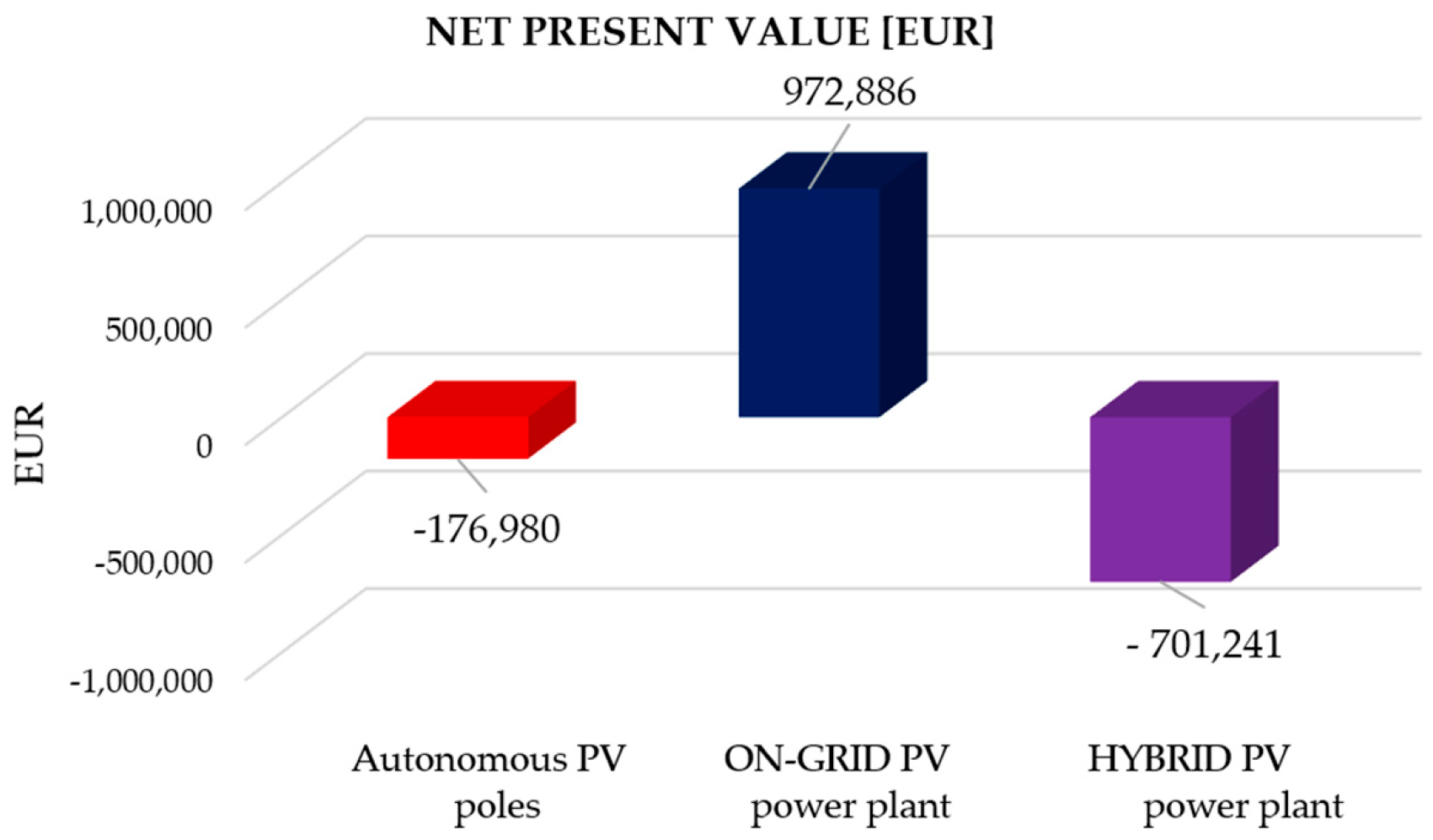
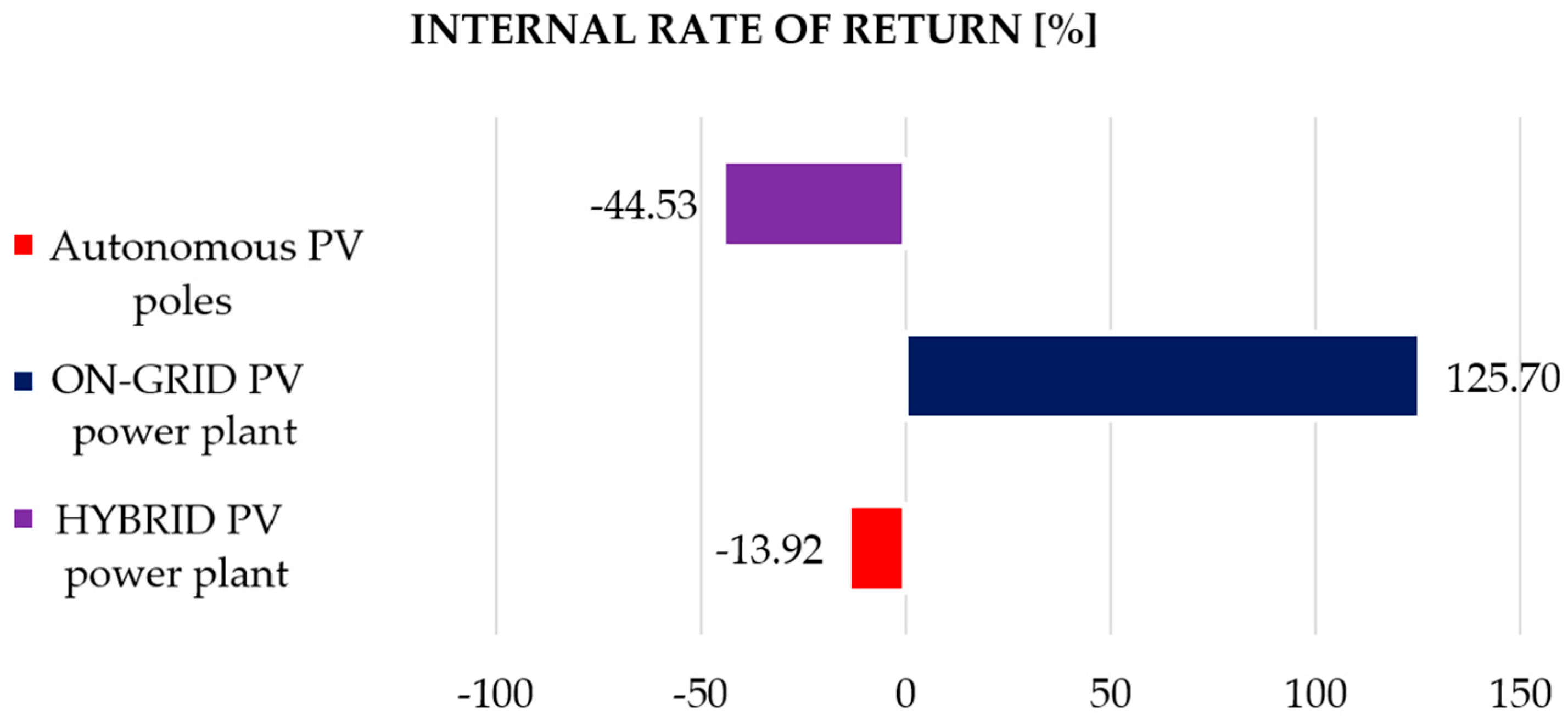
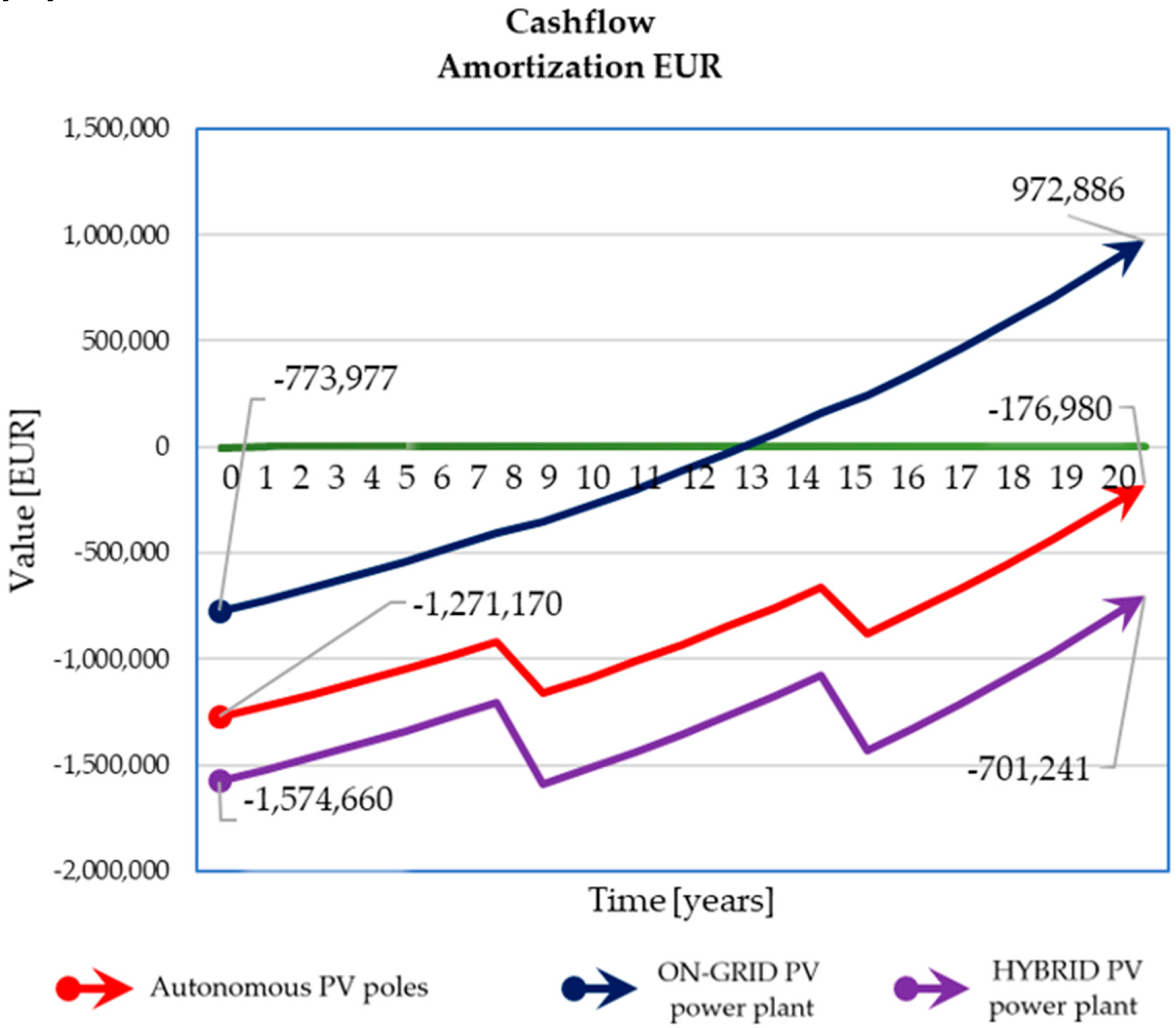
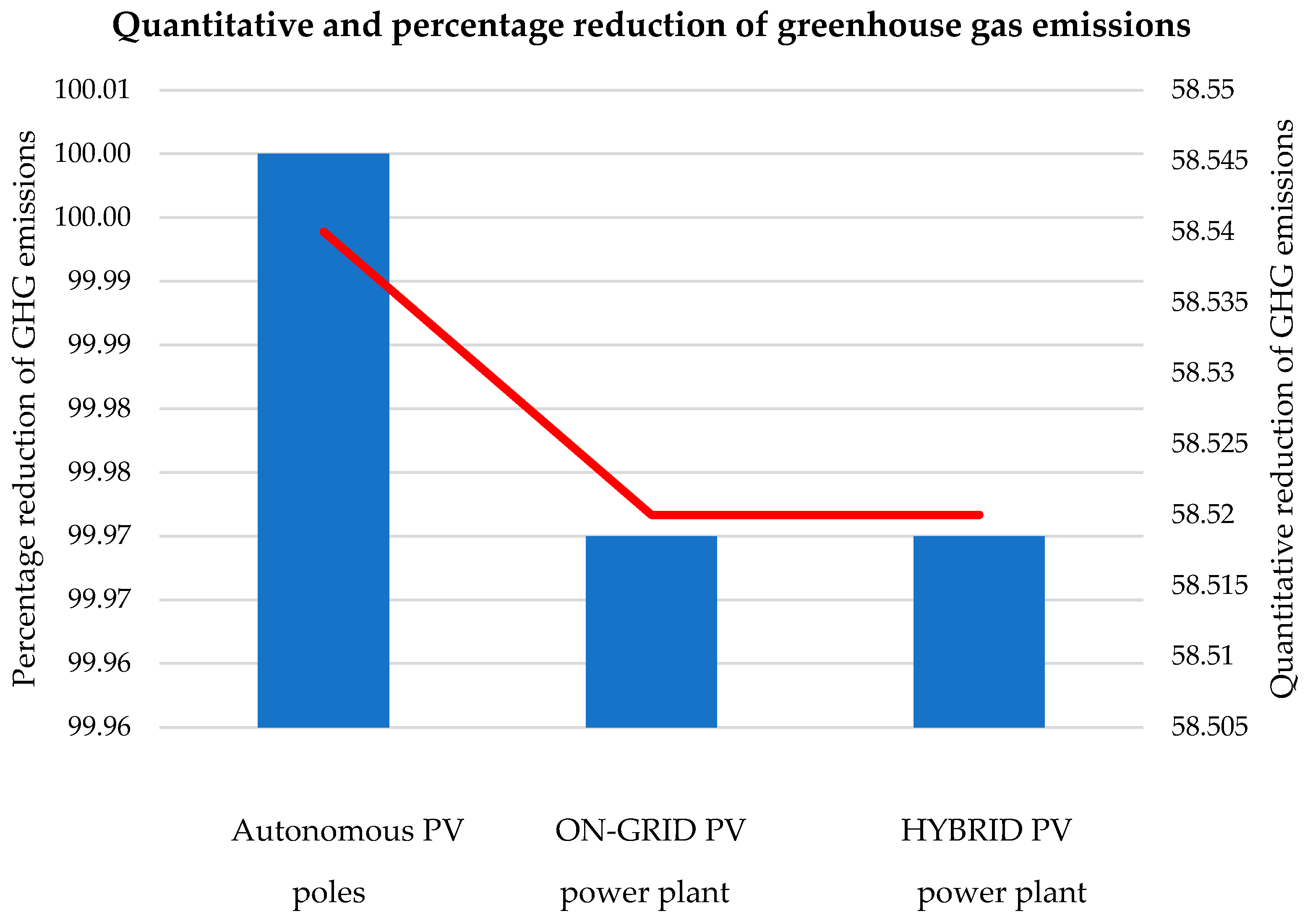
| Road Class | Power of the Lighting Fixture [W] | Number of Lighting Fixtures | Installed Power [kW] |
|---|---|---|---|
| Technical class II (national road—M4) | 100 | 180 | 18.00 |
| Technical class IV (communal road—M5) | 60 | 46 | 2.76 |
| Technical class IV (local road—M6) | 50 | 500 | 25.00 |
| TOTAL | 45.76 |
| Estimation of the Energy Consumption of the Analyzed Public Lighting System. | |||
|---|---|---|---|
| Month | Operating Hours | Installed Power [kW] | Monthly Energy Consumption [kWh] |
| January | 432.45 | 45.76 | 19,788.91 |
| February | 346.36 | 45.76 | 15,849.43 |
| March | 343.17 | 45.76 | 15,703.46 |
| April | 279.00 | 45.76 | 12,767.04 |
| May | 268.15 | 45.76 | 12,270.54 |
| June | 219.00 | 45.76 | 10,021.44 |
| July | 244.28 | 45.76 | 11,178.25 |
| August | 279.00 | 45.76 | 12,767.04 |
| September | 321.00 | 45.76 | 14,688.96 |
| October | 358.67 | 45.76 | 16,412.74 |
| November | 397.50 | 45.76 | 18,189.60 |
| December | 389.05 | 45.76 | 17,802.93 |
| Schedule for Switching On and Off Public Lighting, with Monthly Adjustment (Considering the Average Values) | ||||
|---|---|---|---|---|
| No. Crt. | Month | Period | Zone 1 | |
| Switch-On Time | Switch-Off Time | |||
| 0 | 1 | 2 | 3 | 4 |
| 1 | January | 1–31 | 17:22 | 7:17 |
| 2 | February | 1–28 | 18:00 | 6:37 |
| 3 | March | 1–31 | 18:40 | 5:47 |
| 4 | April | 1–30 | 19:17 | 4:47 |
| 5 | May | 1–31 | 19:52 | 4:17 |
| 6 | June | 1–30 | 20:22 | 3:52 |
| 7 | July | 1–31 | 20:12 | 4:00 |
| 8 | August | 1–31 | 19:37 | 4:37 |
| 9 | September | 1–30 | 18:52 | 5:22 |
| 10 | October | 1–31 | 18:00 | 5:57 |
| 11 | November | 1–30 | 17:10 | 6:35 |
| 12 | December | 1–31 | 18:52 | 7:07 |
| Parameter | Options | Evaluation Index VWS | Selected Criterion | ||
|---|---|---|---|---|---|
| National Road | Communal Road | Local Road | |||
| Velocity | Very high (V ≥ 100 km/h) | 2 | 0 | −1 | −1 |
| High (70 < V < 100 km/h) | 1 | ||||
| Moderate (40 < V < 70 km/h) | 0 | ||||
| Low (V ≤ 40 km/h) | −1 | ||||
| Traffic volume | High | 1 | 0 | 0 | −1 |
| Moderate | 0 | ||||
| Low | −1 | ||||
| Traffic composition | Mixed, with a high percentage of non-motorized vehicles | 2 | 1 | 1 | 1 |
| Mixt | 1 | ||||
| Only motorized vehicles | 0 | ||||
| Separation of traffic directions | No | 1 | 1 | 1 | 1 |
| Yes | 0 | ||||
| Intersection density | High (>3/km) | 1 | 1 | 1 | 1 |
| Moderate (≤3/km) | 0 | ||||
| Parked vehicles | Yes | 1 | 0 | 0 | 0 |
| No | 0 | ||||
| Ambient lighting | High | 1 | −1 | −1 | −1 |
| Moderate | 0 | ||||
| Low | −1 | ||||
| Navigation load | Poor | 1 | 0 | 0 | 0 |
| Good | 0 | ||||
| Very good | −1 | ||||
| Sum of weighted values (VWS) | 2 | 1 | 0 | ||
| The lighting class number is calculated as follows: M = 6 − VWS | |||||
| Resulting lighting class | M4 | M5 | M6 | ||
| National Road—Lighting System Class M4 | |
|---|---|
| Characteristics | |
| Distance between poles | 40.00 m |
| Height of the light point | 9.00 m |
| Bracket extension of the light point | 4.00 m |
| Overhang (advancement) (A) | −2.00 m |
| Bracket tilt | 15° |
| Bracket length | 2.00 m |
| Parameter | Calculated | Nominal |
|---|---|---|
| Lm | 0.76 cd/m2 | ≥0.75 cd/m2 |
| Uo | 0.58 | ≥0.40 |
| UI | 0.81 | ≥0.60 |
| TI | 15% | ≥15% |
| REI | 0.68 | ≥0.30 |
| Communal Road—Lighting System Class M5 | |
|---|---|
| Parameter | |
| Distance between poles | 50.00 m |
| Height of the light point | 8.00 m |
| Clearance (R) | 1.50 m |
| Bracket extension of the light point | −0.50 m |
| Bracket tilt | 15° |
| Bracket length | 1.00 m |
| Parameter | Calculated | Nominal |
|---|---|---|
| Lm | 0.51 cd/m2 | ≥0.50 cd/m2 |
| Uo | 0.44 | ≥0.35 |
| UI | 0.47 | ≥0.40 |
| TI | 15% | ≥15% |
| REI | 0.79 | ≥0.30 |
| Local Road—Lighting System Class M6 | |
|---|---|
| Parameter | |
| Distance between poles | 50.00 m |
| Height of the light point | 8.00 m |
| Clearance (R) | 0.80 m |
| Bracket extension of the light point | 0.20 m |
| Bracket tilt | 15° |
| Bracket length | 1.00 m |
| Parameter | Calculated | Nominal |
|---|---|---|
| Lm | 0.44 cd/m2 | ≥0.30 cd/m2 |
| Uo | 0.44 | ≥0.35 |
| UI | 0.45 | ≥0.40 |
| TI | 12% | ≥20% |
| REI | 0.72 | ≥0.30 |
| Component | Parameter | Value | Quantity |
|---|---|---|---|
| Monocrystalline photovoltaic panel [33] | Nominal electrical power | 550 W | 2 pieces |
| Nominal current | 13.20 A | ||
| Short-circuit current | 14.00 A | ||
| Nominal voltage | 41.70 V | ||
| Open circuit voltage | 49.60 V | ||
| Dimensions | 2.261 × 1134 × 30 mm | ||
| Solar regulator [34] | Maximum voltage | 100 V | 1 piece |
| Maximum charging current | 15.00 A | ||
| Low-voltage disconnect | 22.00 V | ||
| Reconnect | 25.20 V | ||
| Boost charging voltage | 28.80 V | ||
| Overvoltage protection | Yes | ||
| Reverse polarity protection | Yes | ||
| Degree of protection | IP32 | ||
| Size | 133.50 × 70 × 35 mm | ||
| Weight | 165 g | ||
| Gel solar battery [35] | Nominal voltage | 12 V | 2 pieces |
| Capacity | 150 Ah | ||
| Dimensions (L × l × h) | 485 × 172 × 240 mm | ||
| Weight | 44 kg | ||
| LED street lighting fixture [36] | Power | 100 W | 1 piece |
| Nominal voltage | 24 V | ||
| Degree of protection | IP65 | ||
| LED type | multiled | ||
| Auxiliary materials [20,37] | Battery box IP65, connectivity, protections, conductors, metal support, brackets, and OL-Zn collars | ||
| Description | Euro (Including VAT) | Pieces | Total Euro (Including VAT) |
|---|---|---|---|
| Obj. 1 Remove existing lighting fixtures | 25.85 | 726 | 18,763.42 |
| 1.1. Remove existing lighting fixtures | 25.85 | 726 | 18,763.42 |
| Obj. 2 Autonomous photovoltaic pole—NR (M4) | 1854.41 | 180 | 333,793.64 |
| 2.1. Equipment | 1150.50 | 180 | 207,089.17 |
| 2.1.1. Monocrystalline photovoltaic panel 550 W | 157.79 | 360 | 56,803.54 |
| 2.1.2. Charge controllers 100 V 15 A | 73.34 | 180 | 13,201.93 |
| 2.1.3. Solar battery 12 V 150 Ah | 331.27 | 360 | 118,999.04 |
| 2.1.4. LED lighting fixture 24 V 100 W | 100.47 | 180 | 18,084.65 |
| 2.2. Street photovoltaic pole | 487.77 | 180 | 87,798.03 |
| 2.3. Installation of machinery/equipment | 216.15 | 180 | 38,906.45 |
| Obj. 3 Autonomous photovoltaic pole—CR (M5) | 1453.80 | 46 | 66,874.69 |
| 3.1. Equipment | 752.46 | 46 | 34,613.41 |
| 3.1.1. Monocrystalline photovoltaic panel 300 W | 110.07 | 92 | 10,126.16 |
| 3.1.2. Charge controllers 100 V 15 A | 73.34 | 46 | 3373.83 |
| 3.1.3. Solar battery 12 V 120 Ah | 247.56 | 72 | 17,824.51 |
| 3.1.4. LED lighting fixture 24 V 60 W | 71.50 | 46 | 3288.91 |
| 3.2. Street photovoltaic pole | 485.18 | 46 | 22,318.52 |
| 3.3. Installation of machinery/equipment | 216.15 | 46 | 9942.76 |
| Obj. 4 Autonomous photovoltaic pole—LR (M6) | 1352.20 | 500 | 676,098.15 |
| 4.1. Equipment | 650.87 | 500 | 325,432.06 |
| 4.1.1. Monocrystalline photovoltaic panel 250 W | 110.32 | 1000 | 110,319.80 |
| 4.1.2. Charge controllers 75 V 10 A | 73.34 | 500 | 36,672.04 |
| 4.1.3. Solar battery 12 V 100 Ah | 158.65 | 1000 | 158,646.74 |
| 4.1.4 LED lighting fixture 24 V 60 W | 39.59 | 500 | 19,793.48 |
| 4.2. Street photovoltaic pole | 485.18 | 500 | 242,592.63 |
| 4.3. Installation of machinery/equipment | 216.15 | 500 | 108,073.46 |
| TOTAL | 1750.92 | 726 | 1,271,170.15 |
| TOTAL C + I | 777.22 | 726 | 564,263.86 |
| Description | Unit | Value |
|---|---|---|
| Total investment value | EUR | 1,271,170.15 |
| Maintenance costs | EUR | 729,290.55 |
| The value of the economy per year | EUR | 91,173.99 |
| Net Present Income (NPI) | EUR | −176,980.80 |
| Discount rate | % | 5 |
| Lifespan of the solution | YEARS | 20 |
| Payback Time (PBT) | YEARS | 13.94 |
| Discounted Payback Time (DPBT) | YEARS | 21.94 |
| Internal rate of return (IRR) | % | −13.92 |
| Description | Total Euro (Including VAT) |
|---|---|
| Obj. 1 Utilities | 87,076.34 |
| 1.1. Electric connection | 79,719.02 |
| 1.2. Telecommunications—data voice | 7357.32 |
| Obj. 2 Land development | 79,695.46 |
| 2.1. Removal of the topsoil layer (2.448 m2) | 7965.32 |
| 2.2. Fencing (203.00 m, with a 4.00 m vehicle access gate and a 1.00 m pedestrian access gate) | 30,164.68 |
| 2.3. Foundations for lighting poles | 4920.10 |
| 2.4. Container platforms for personnel and transformer station | 16,058.21 |
| 2.5. Access road made of stone (40.00 m) | 20,587.14 |
| Obj. 3 Photovoltaic power plant 153,90 kWp | 373,524.51 |
| 3.1. Foundations for metal supports | 58,907.70 |
| 3.2. Supports for photovoltaic panels | 122,241.18 |
| 3.3. Wiring and accessories | 101,313.45 |
| 3.4. Grounding | 21,204.10 |
| 3.5. Junction boxes for PV (22 pieces) | 32,711.14 |
| 3.6. Photovoltaic power plant panel board | 14,479.95 |
| 3.7. Earthworks | 16,217.02 |
| 3.8. Lighting poles (6 pieces) | 4641.87 |
| 3.9. Transport | 1808.09 |
| Obj. 4 Video surveillance subsystem | 14,747.55 |
| 4.1. Earthworks | 6105.62 |
| 4.2. Trenches and cables | 3110.25 |
| 4.3. Equipment | 4232.23 |
| 4.4. Transport | 1299.46 |
| Obj. 5 Installation of machines/equipment | 150,156.38 |
| 5.1. Equipment | 129,768.38 |
| 5.1.1. Monocrystalline photovoltaic panel 450 W (342 pieces) | 103,015.46 |
| 5.1.2. 60 kW three-phase grid-connected inverter (3 pieces) | 21,422.51 |
| 5.1.3. UPS 3000 VA 2U RACK | 2377.98 |
| 5.1.4. Outdoor video surveillance camera (12 pieces) | 1017.56 |
| 5.1.5. NVR 32 CH | 703.30 |
| 5.1.6. Street lighting fixture LED 80 W | 1231.57 |
| 5.2. Installation of machinery/equipment | 20,388.01 |
| TOTAL | 773,977.22 |
| TOTAL C + I | 611,300.46 |
| Description | Unit | Value |
|---|---|---|
| Total investment value | EUR | 773,977.22 |
| Maintenance costs | EUR | 75,943.55 |
| Annual savings value | EUR | 91,140.36 |
| Net Present Income (NPI) | EUR | 972,886.48 |
| Discount rate | % | 5 |
| Lifespan of the solution | YEARS | 20 |
| Payback Time (PBT) | YEARS | 8.49 |
| Discounted Payback Time (DPBT) | YEARS | 9.33 |
| Internal rate of return (IRR) | % | 125.70 |
| Description | Total Euro (Including VAT) |
|---|---|
| Obj. 1 Utilities—similar to grid-connected PV system | 87,076.34 |
| Obj. 2 Land development—similar to grid-connected PV system | 79,695.46 |
| Obj. 3 Photovoltaic power plant 153.90 kWp | 422,934.97 |
| 3.1.–3.9. Similar to grid-connected PV system | 373,524.51 |
| 3.10. Concrete platforms and containers (energy storage system) | 49,410.46 |
| Obj. 4 Video surveillance subsystem | 14,747.55 |
| Obj. 5 Installation of machines/equipment | 586,878.97 |
| 5.1. Equipment | 530,978.10 |
| 5.1.1. Monocrystalline photovoltaic panel 450 W (342 pieces) | 103,015.46 |
| 5.1.2. 60 kW three-phase grid-connected inverter (3 pieces) | 56,923.80 |
| 5.1.3. UPS 3000 VA 2U RACK | 2377.98 |
| 5.1.4. Outdoor video surveillance camera (12 pieces) | 1017.56 |
| 5.1.5. NVR 32 CH | 703.30 |
| 5.1.6. Street lighting fixture LED 80 W | 1231.57 |
| 5.1.7. Lithium-ion battery storage system B-BOX 13.80 kW (50 pieces) | 365,708.44 |
| 5.2. Installation of machinery/equipment | 55,900.87 |
| TOTAL | 1,574,660.16 |
| TOTAL C + I | 938,978.40 |
| Description | Unit | Value |
|---|---|---|
| Total investment value | EUR | 1,574,660.16 |
| Maintenance costs | EUR | 949,388.73 |
| Annual savings value | EUR | 91,140.36 |
| Net Present Income (NPI) | EUR | −701,241.65 |
| Discount rate | % | 5 |
| Lifespan of the solution | YEARS | 20 |
| Payback Time (PBT) | YEARS | 17.28 |
| Discounted Payback Time (DPBT) | YEARS | 27.69 |
| Internal rate of return (IRR) | % | −44.53 |
| Scenario | Case 1 | Case 2 | Case 3 |
|---|---|---|---|
| Favorable scenario | 2,502,428 | 8,873,577 | −327,061 |
| Unfavorable scenario | −773,708 | 4,298,485 | −3,163,473 |
| Aspect | Autonomous PV Poles | ON-GRID PV Power Plant | HYBRID PV System (PV + Battery + Grid Backup) |
|---|---|---|---|
| Strengths | - Full energy independence - Modular and easy to deploy - No grid connection required | - Lower cost per kWh at scale - Economically efficient for large deployments - Easier to monitor and maintain | - Combines autonomy and efficiency - Provides backup during grid outages - High resilience and flexibility |
| Weaknesses | - Limited storage capacity - Sensitive to adverse weather - Higher unit cost | - Fully dependent on grid availability - Requires centralized space - Potential distribution losses | - Higher upfront cost (PV + battery) - More complex to manage - Needs dual maintenance |
| Opportunities | - Suitable for remote/off-grid areas - Can be integrated into smart city projects - Easy to scale gradually | - Surplus energy can be fed into the grid - Eligible for support schemes (e.g., feed-in tariff, net metering) - Ideal for urban municipalities | - Suitable for unstable grid regions - Can participate in demand–response programs - Scalable and future-proof |
| Threats | - Battery aging and degradation - Blackout risk in poor solar conditions - Legal risk in case of failures | - Vulnerable to energy price fluctuations - Regulatory risk regarding grid injection - May face grid capacity limits | - Higher long-term costs (battery replacement) - Risk of over-engineering for small applications - More points of failure |
Disclaimer/Publisher’s Note: The statements, opinions and data contained in all publications are solely those of the individual author(s) and contributor(s) and not of MDPI and/or the editor(s). MDPI and/or the editor(s) disclaim responsibility for any injury to people or property resulting from any ideas, methods, instructions or products referred to in the content. |
© 2025 by the authors. Licensee MDPI, Basel, Switzerland. This article is an open access article distributed under the terms and conditions of the Creative Commons Attribution (CC BY) license (https://creativecommons.org/licenses/by/4.0/).
Share and Cite
Hudișteanu, V.-S.; Nica, I.; Verdeș, M.; Hudișteanu, I.; Cherecheș, N.-C.; Țurcanu, F.-E.; Gherasim, I.; Galatanu, C.-D. Technical and Economic Analysis of Sustainable Photovoltaic Systems for Street Lighting. Sustainability 2025, 17, 7179. https://doi.org/10.3390/su17167179
Hudișteanu V-S, Nica I, Verdeș M, Hudișteanu I, Cherecheș N-C, Țurcanu F-E, Gherasim I, Galatanu C-D. Technical and Economic Analysis of Sustainable Photovoltaic Systems for Street Lighting. Sustainability. 2025; 17(16):7179. https://doi.org/10.3390/su17167179
Chicago/Turabian StyleHudișteanu, Valeriu-Sebastian, Ionuț Nica, Marina Verdeș, Iuliana Hudișteanu, Nelu-Cristian Cherecheș, Florin-Emilian Țurcanu, Iulian Gherasim, and Catalin-Daniel Galatanu. 2025. "Technical and Economic Analysis of Sustainable Photovoltaic Systems for Street Lighting" Sustainability 17, no. 16: 7179. https://doi.org/10.3390/su17167179
APA StyleHudișteanu, V.-S., Nica, I., Verdeș, M., Hudișteanu, I., Cherecheș, N.-C., Țurcanu, F.-E., Gherasim, I., & Galatanu, C.-D. (2025). Technical and Economic Analysis of Sustainable Photovoltaic Systems for Street Lighting. Sustainability, 17(16), 7179. https://doi.org/10.3390/su17167179







